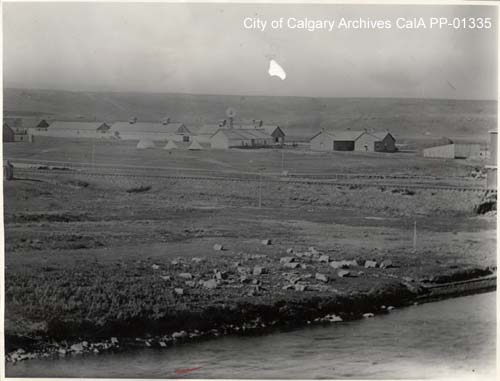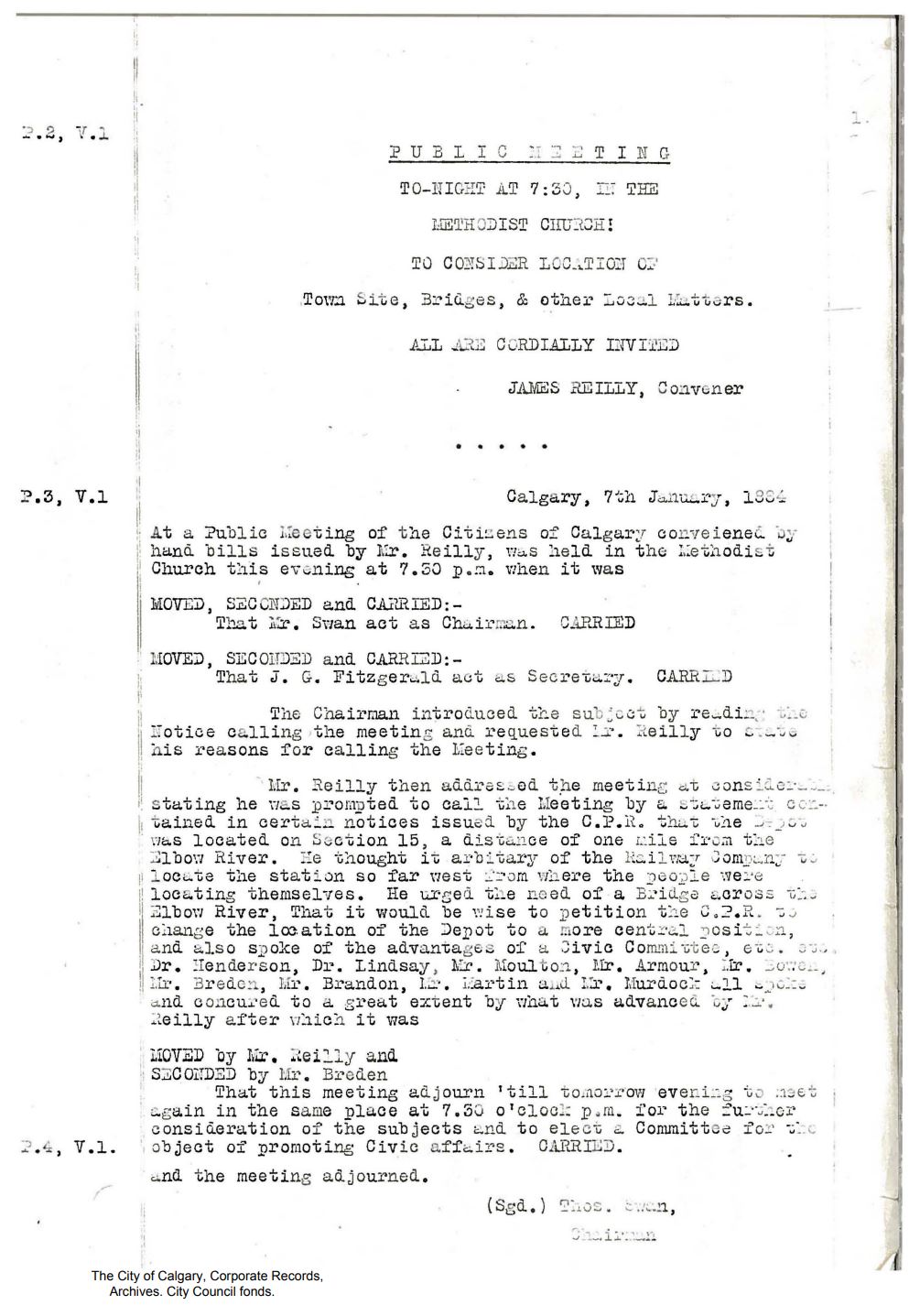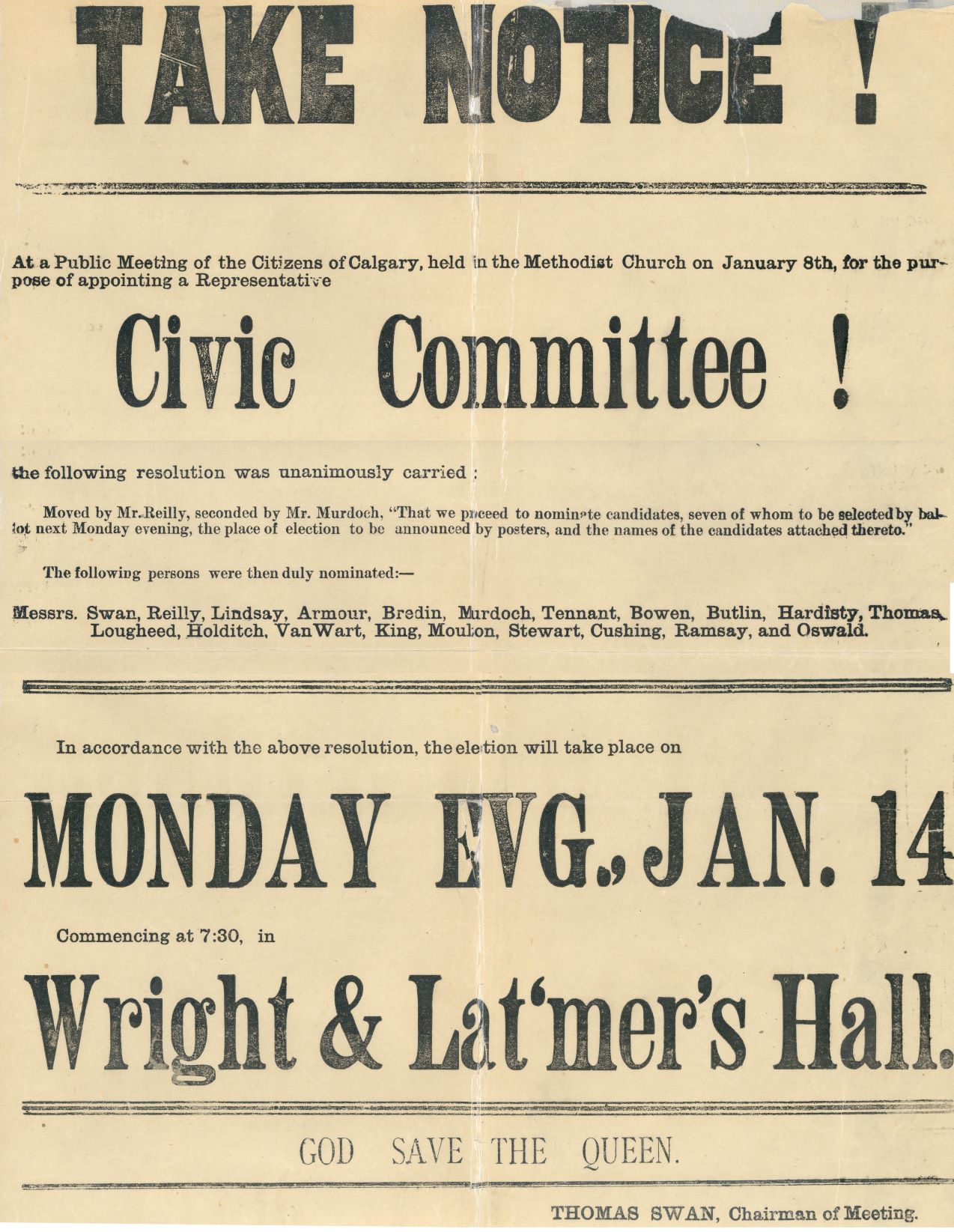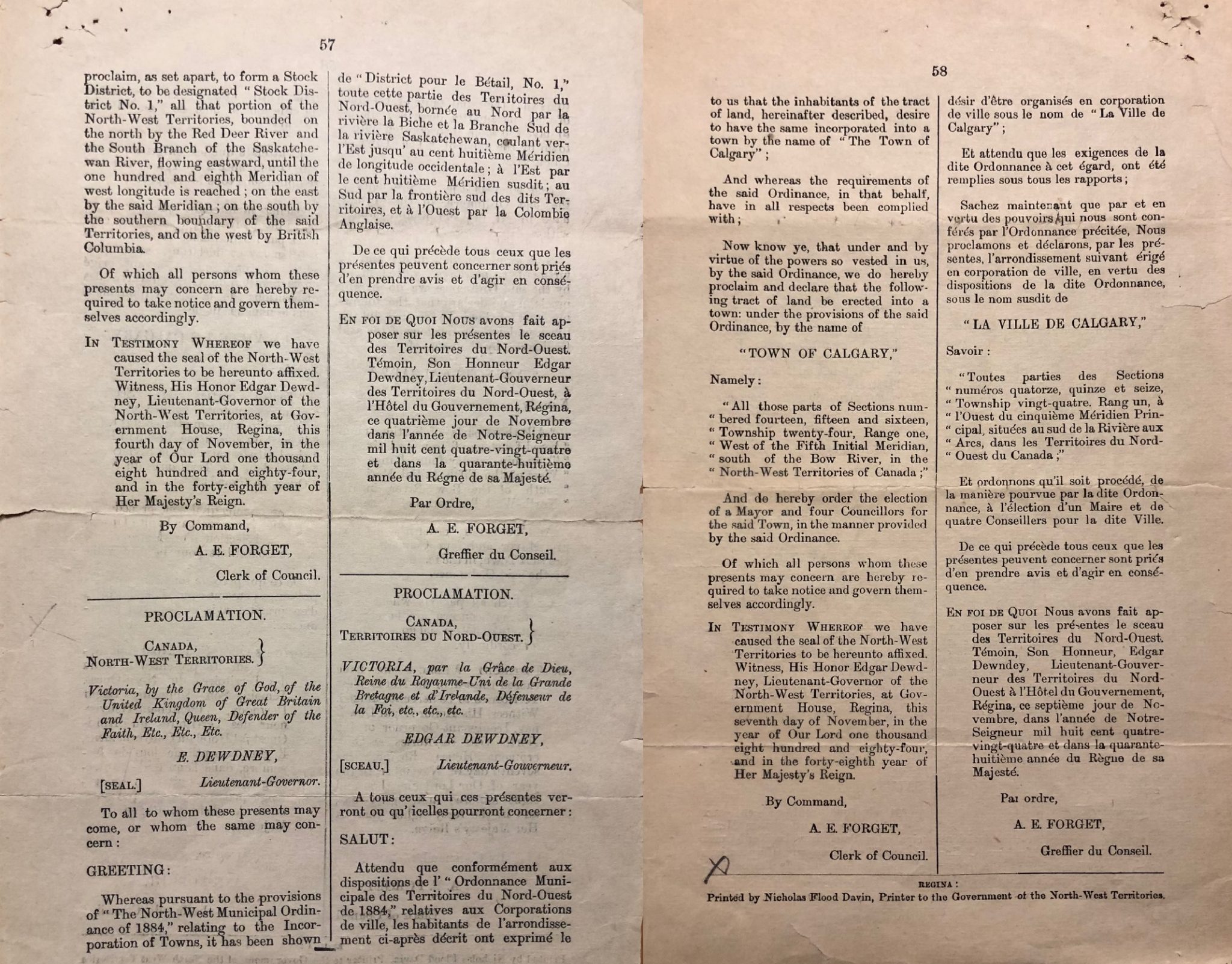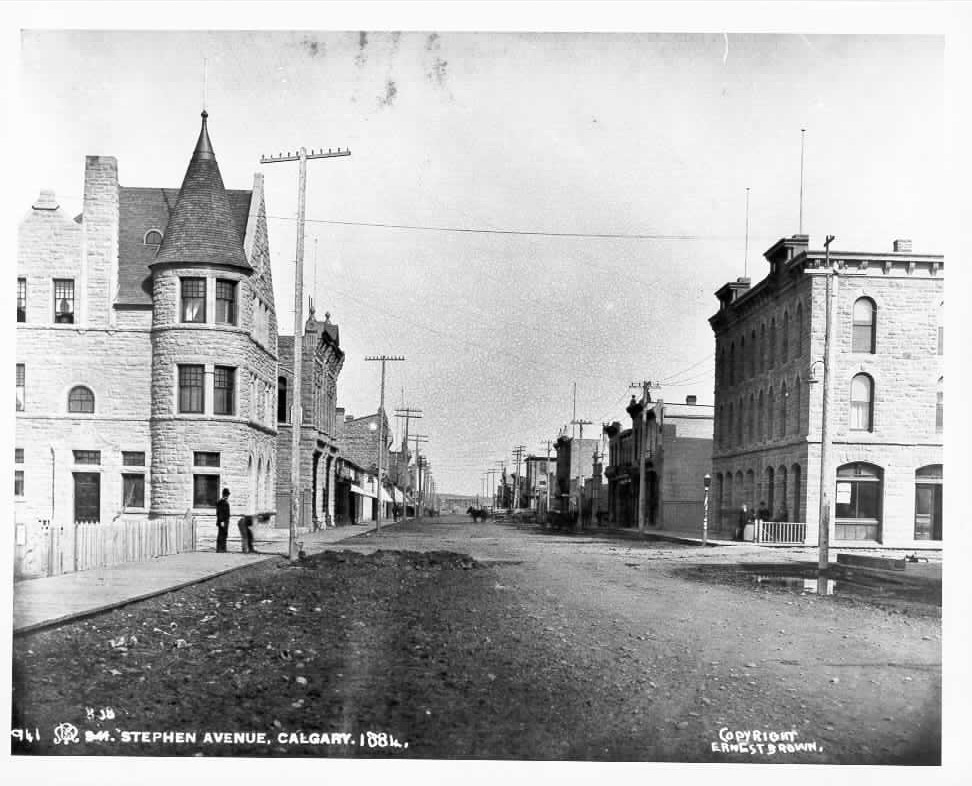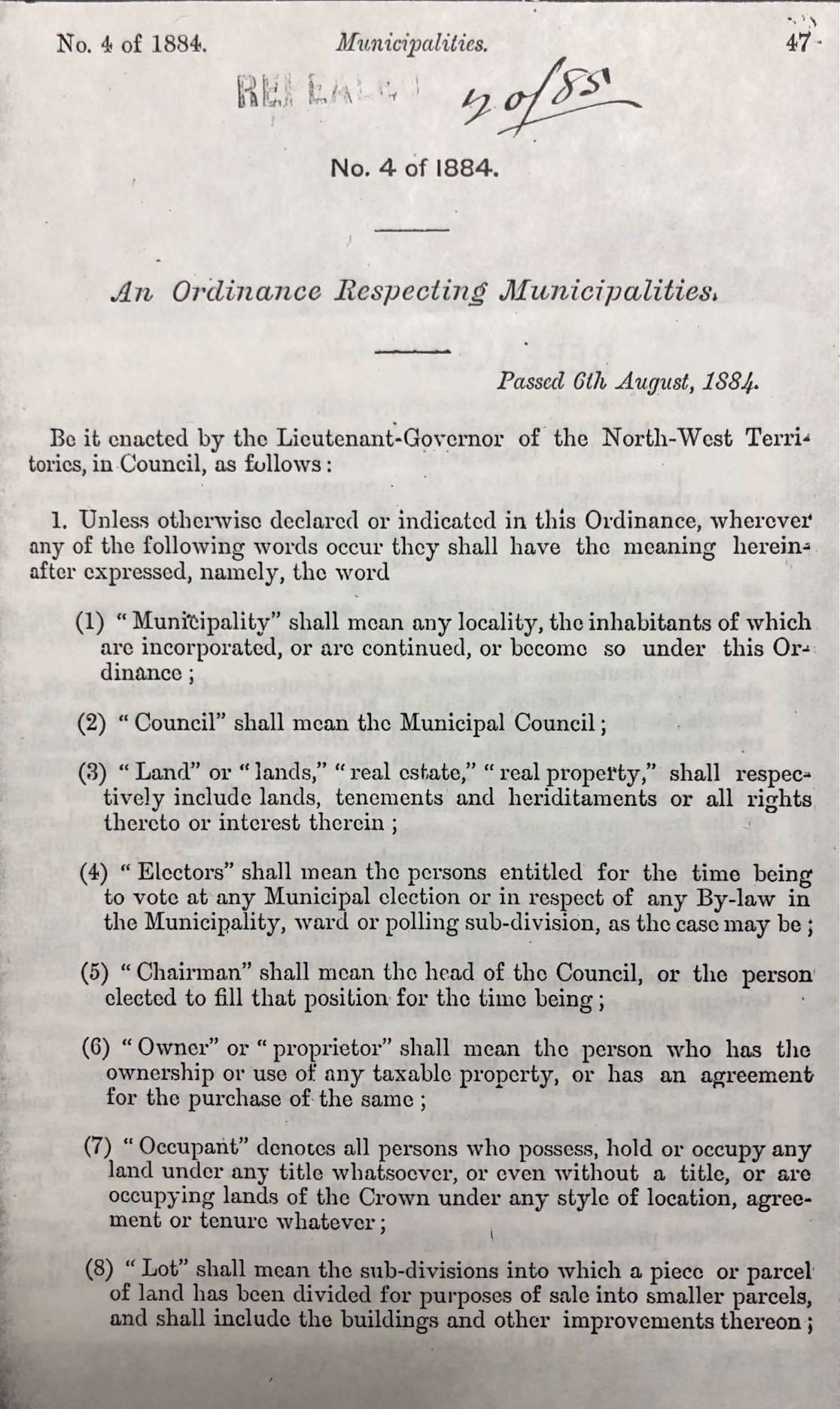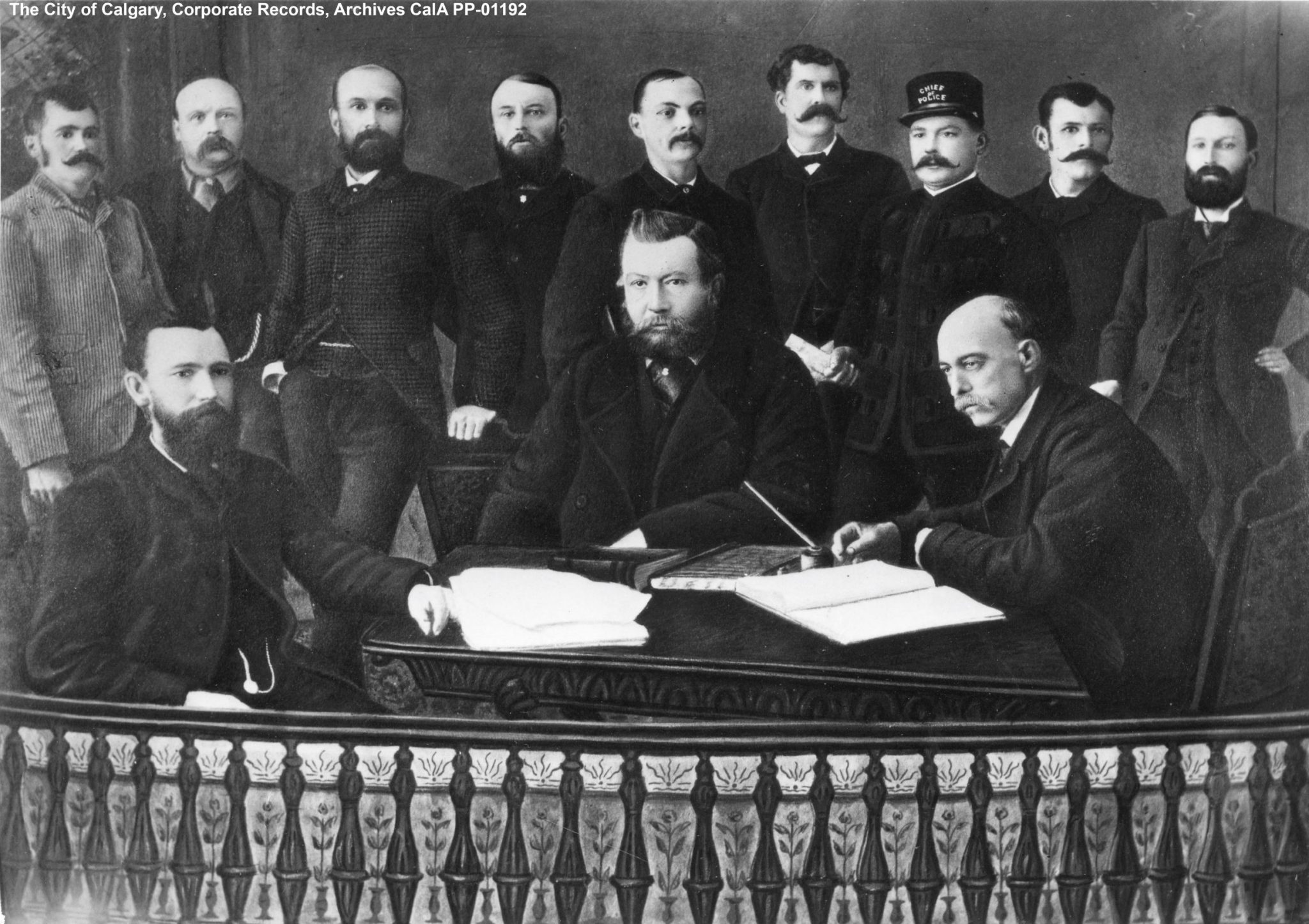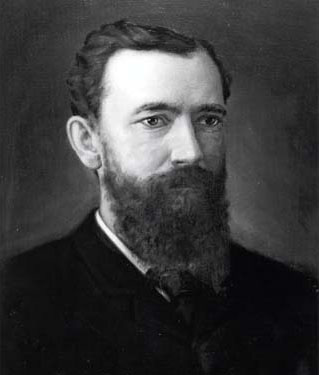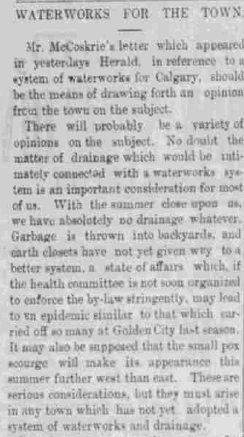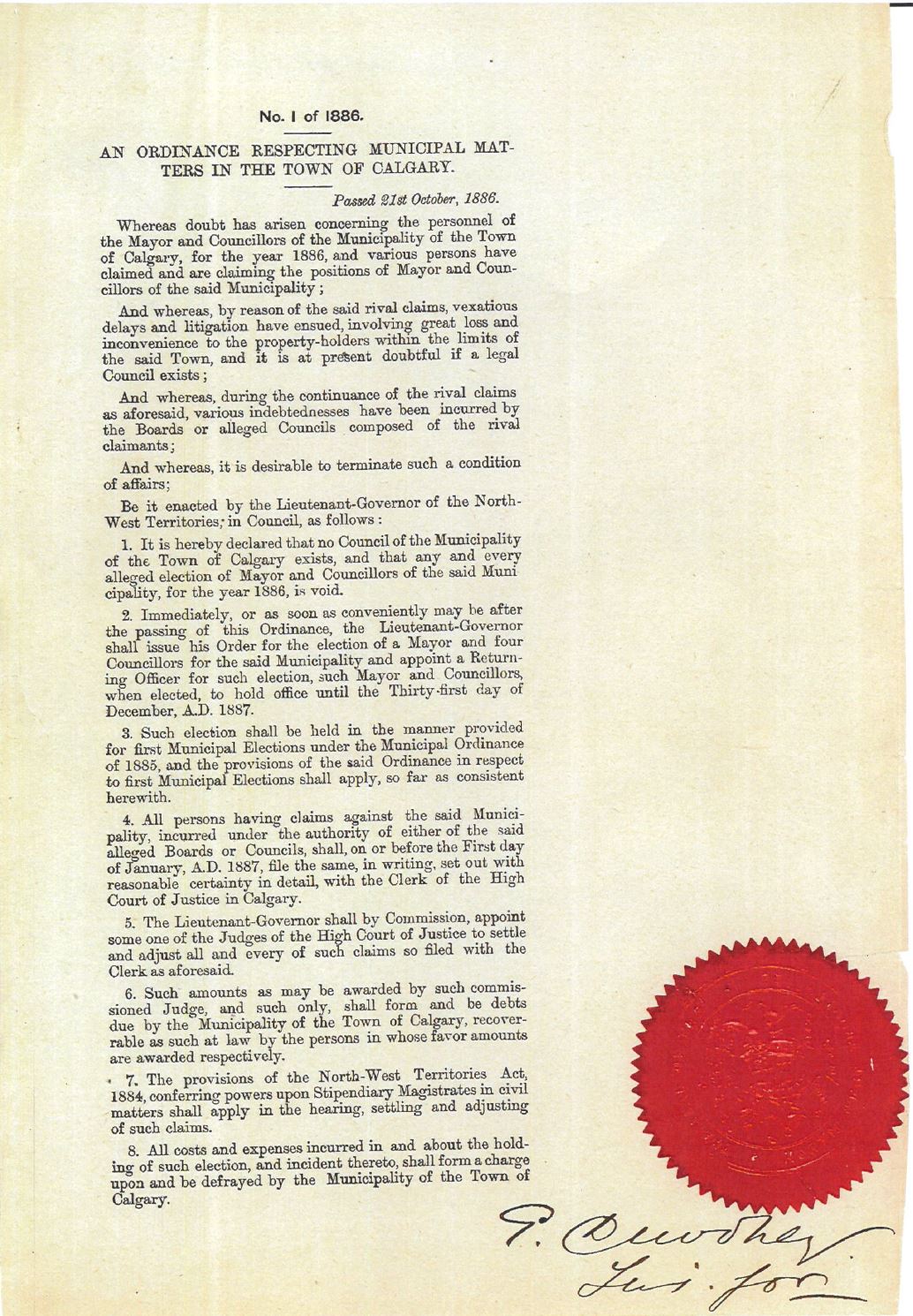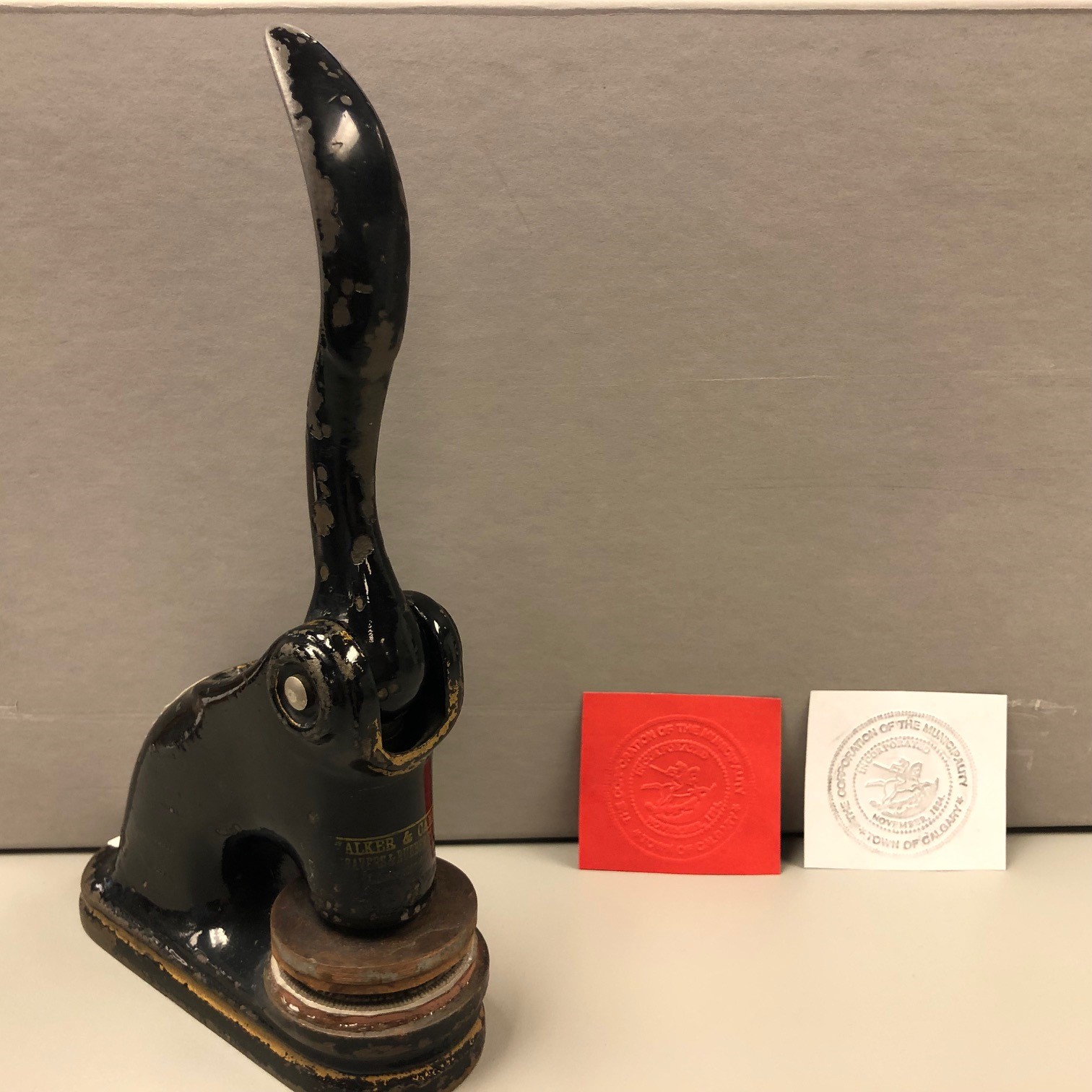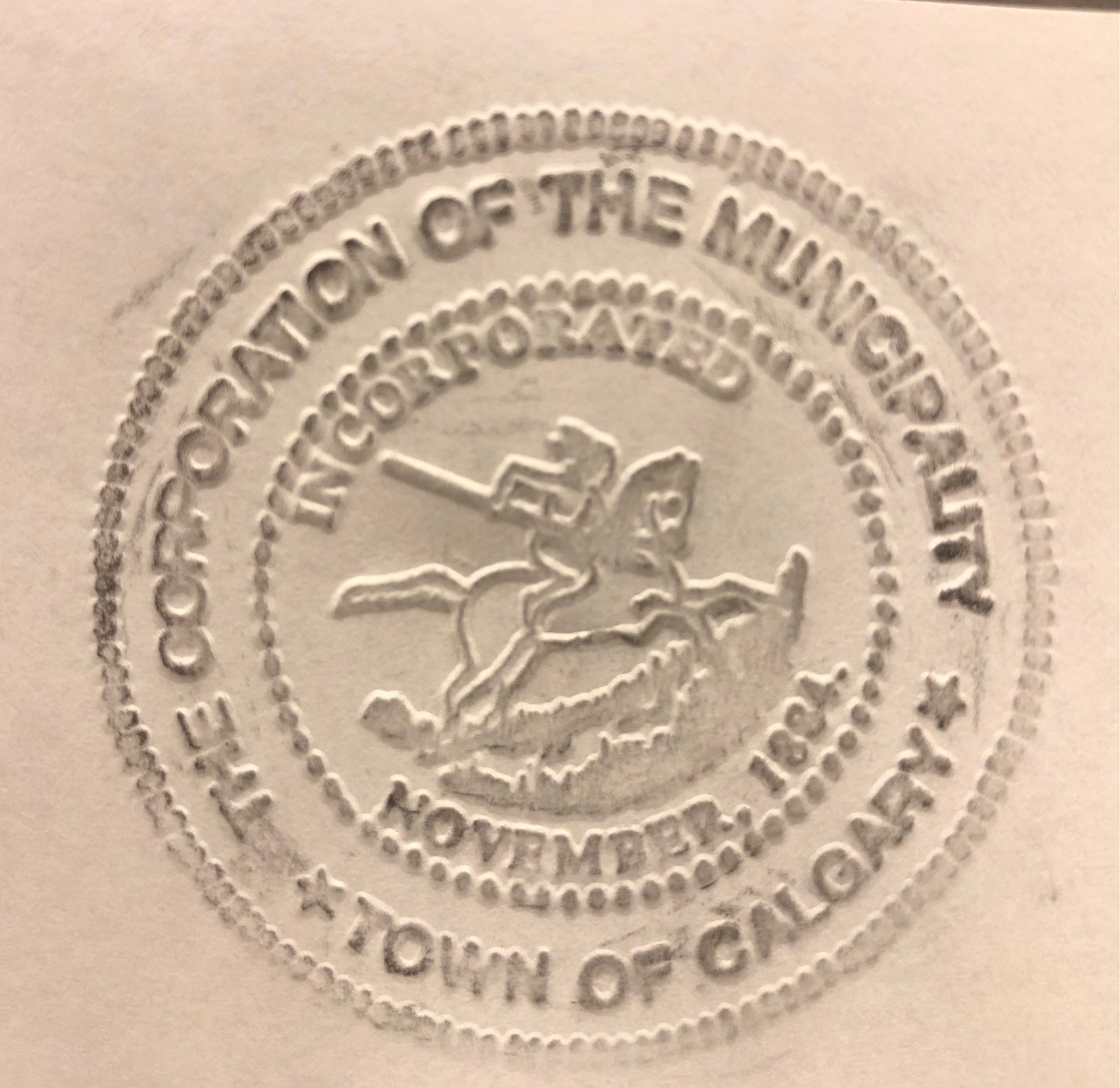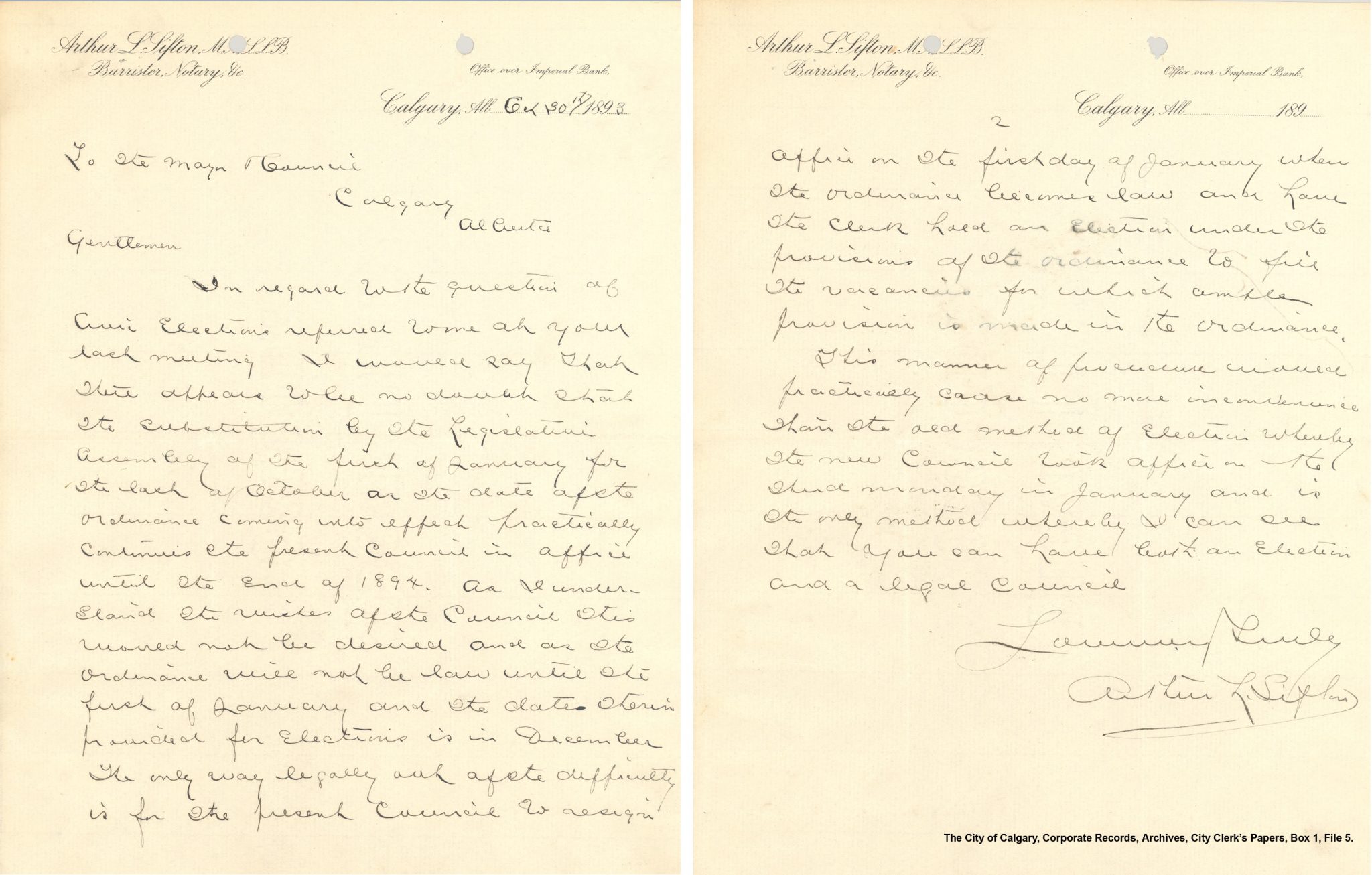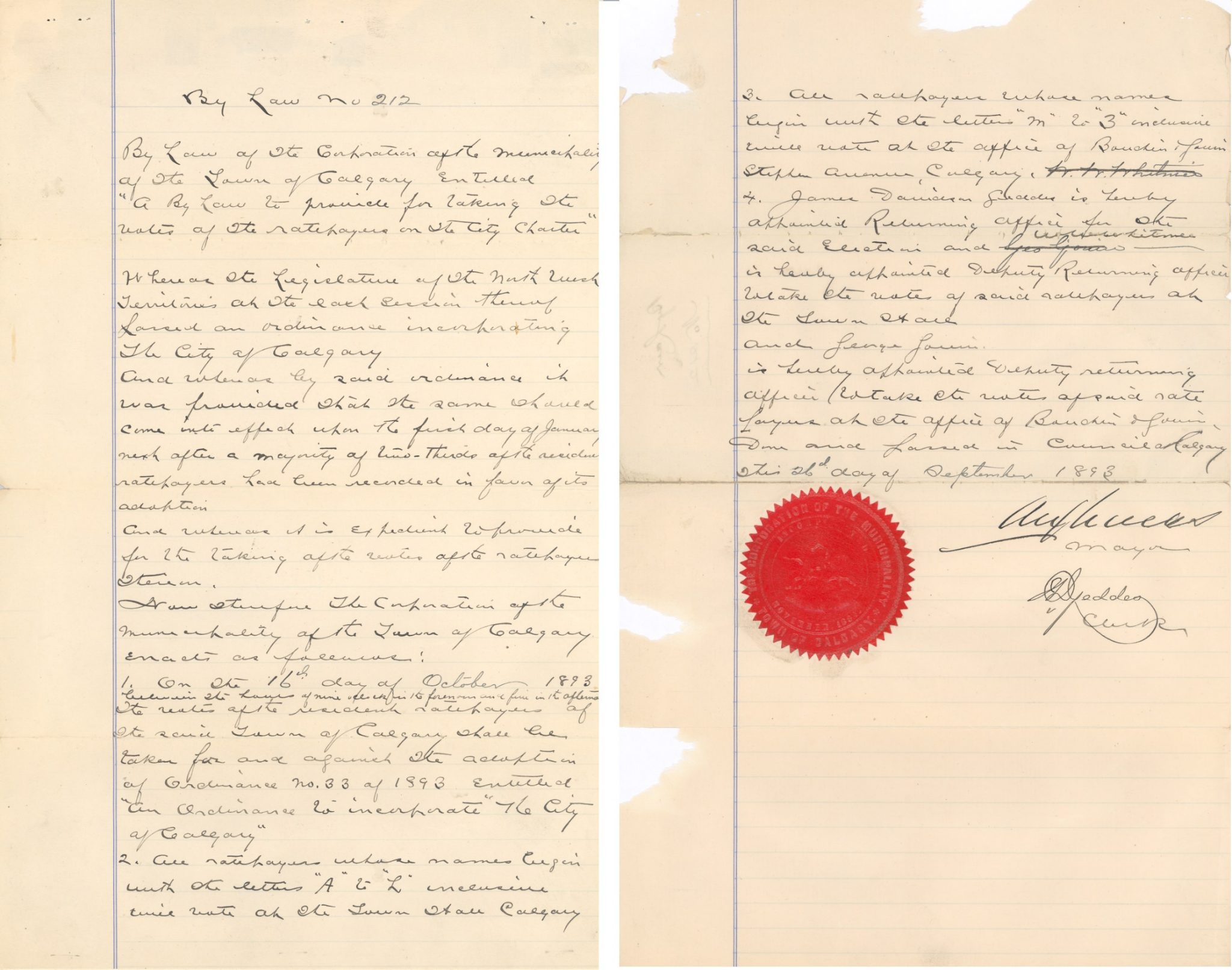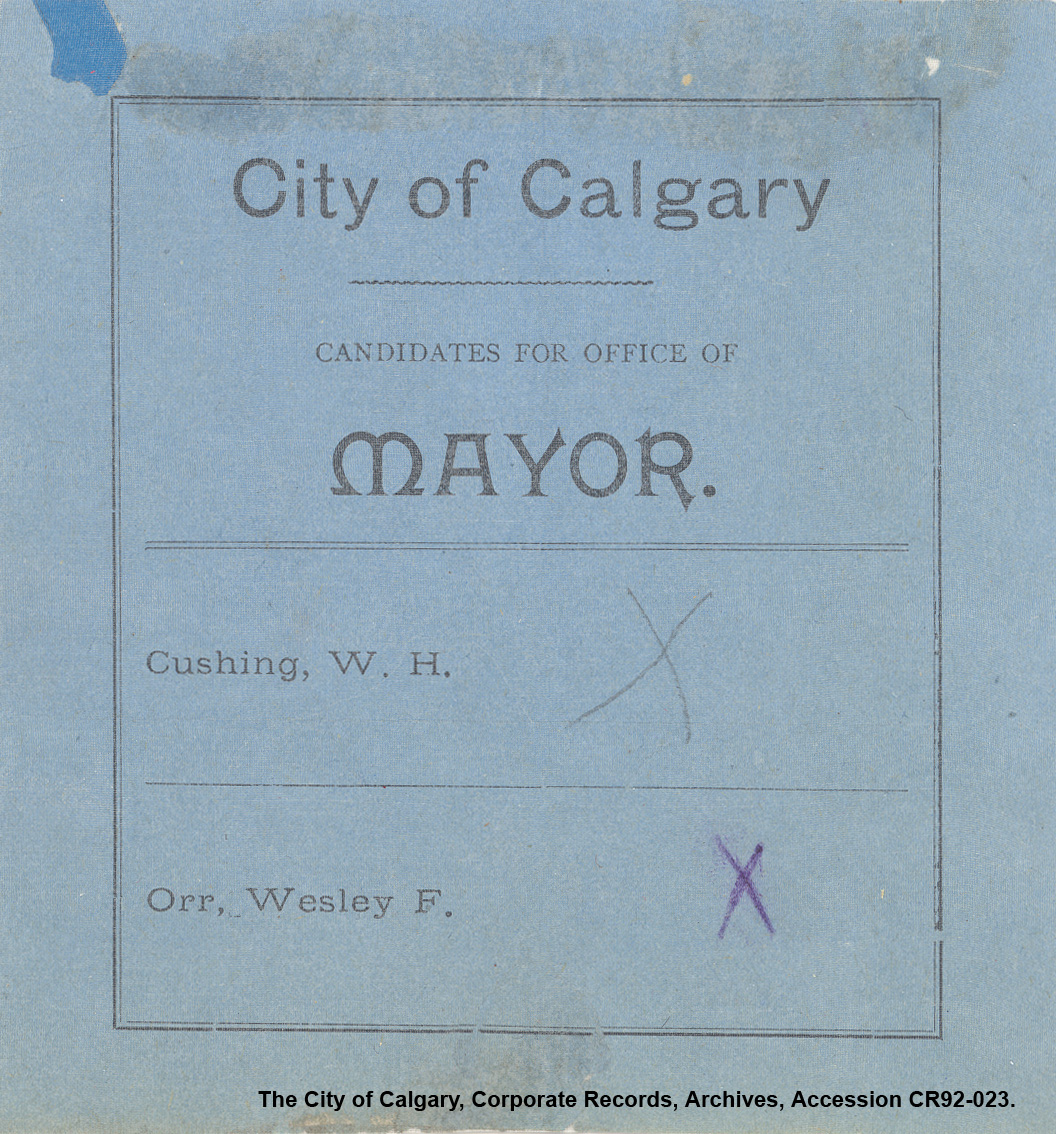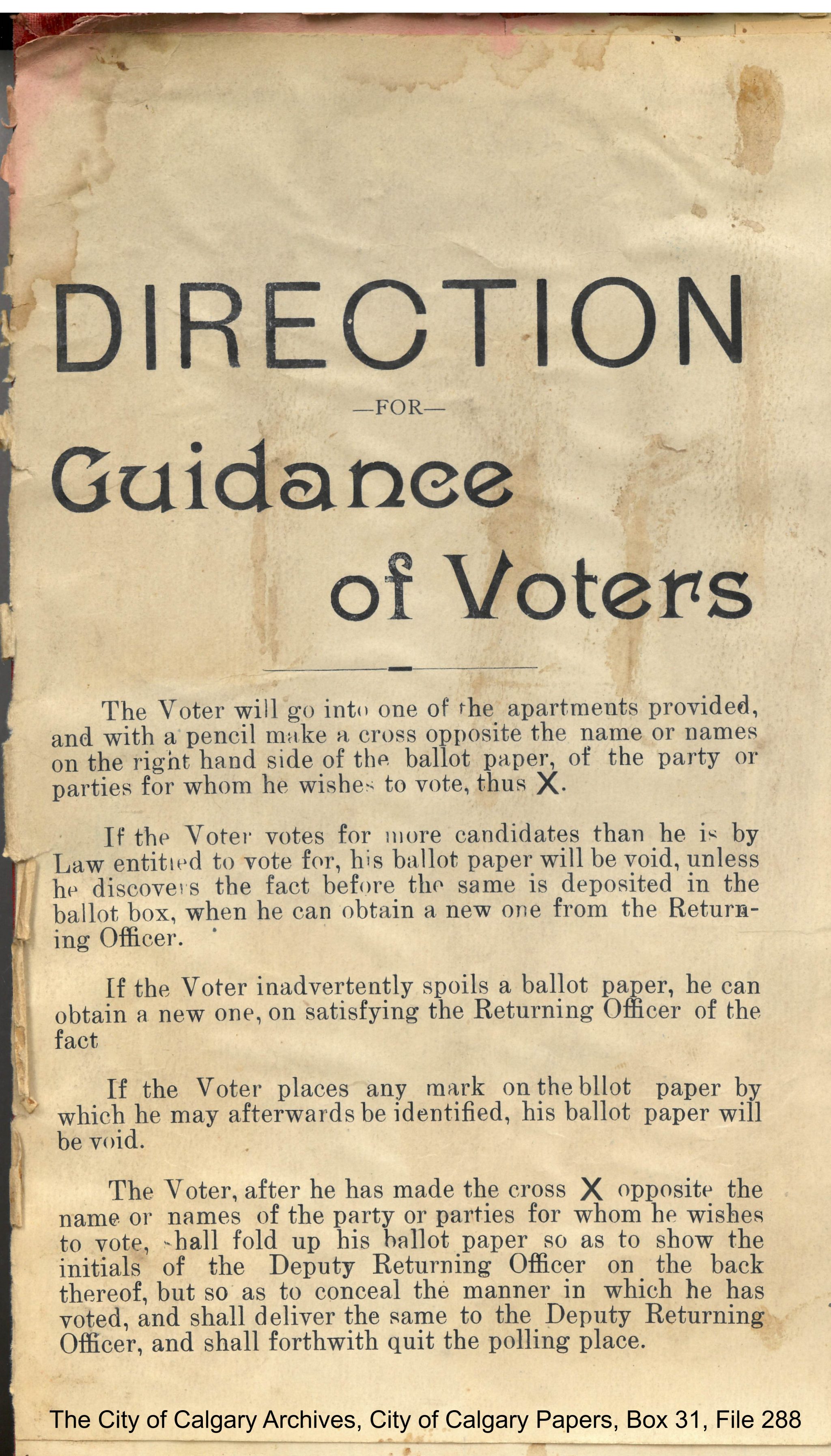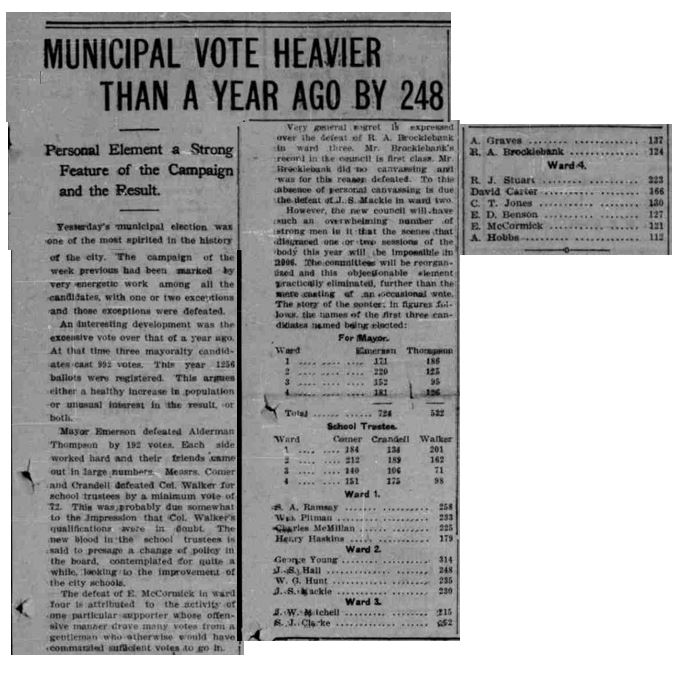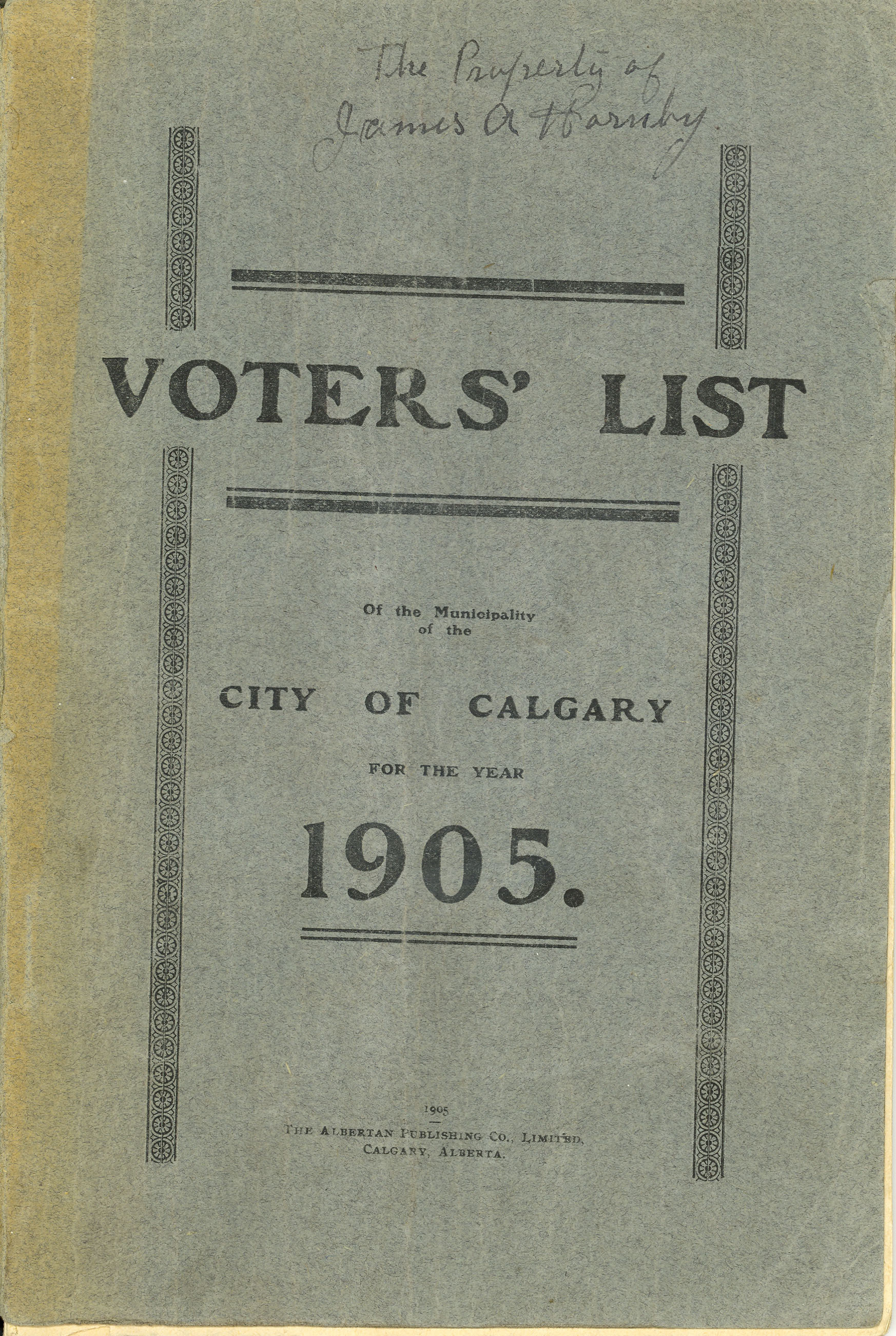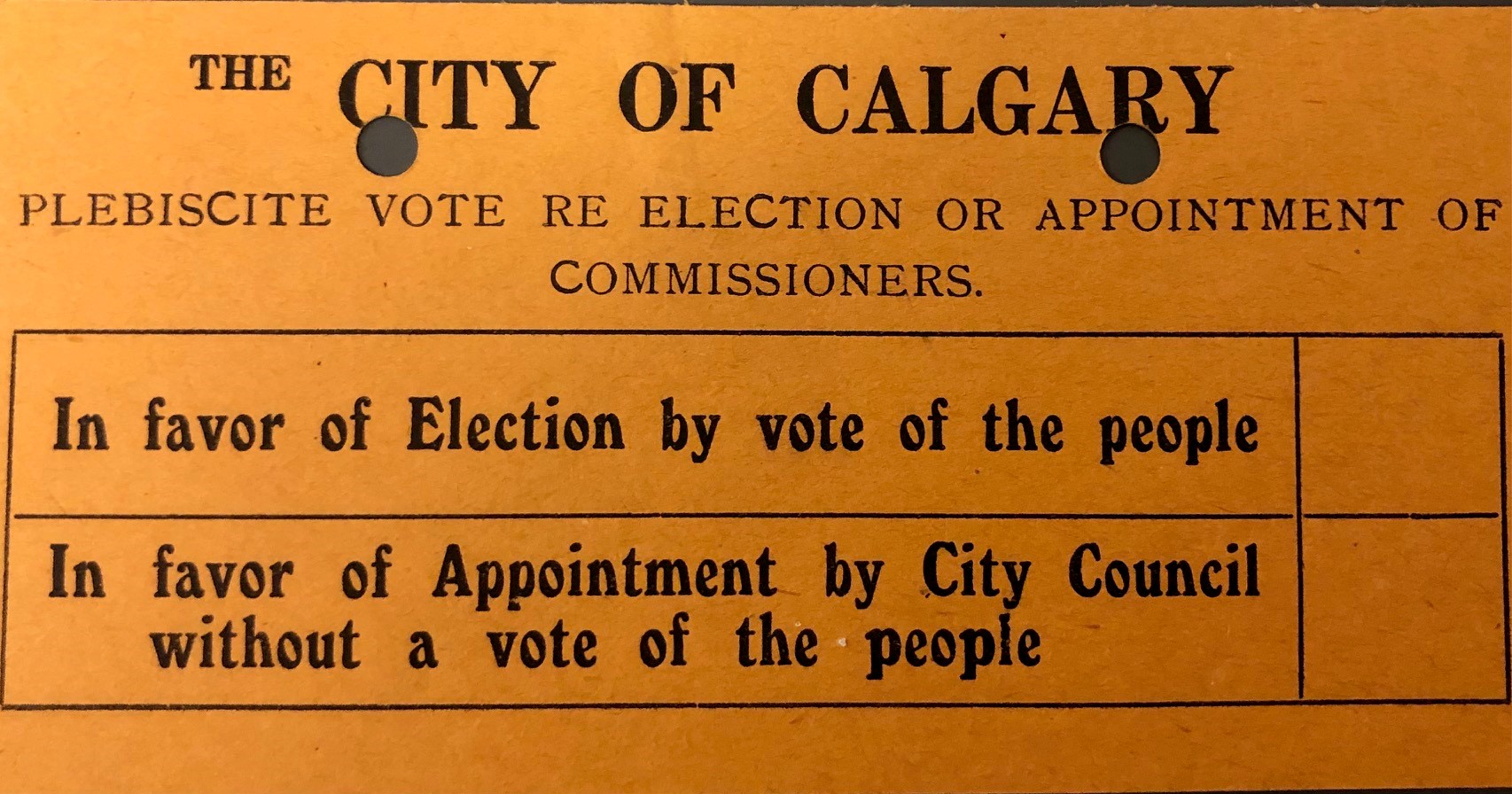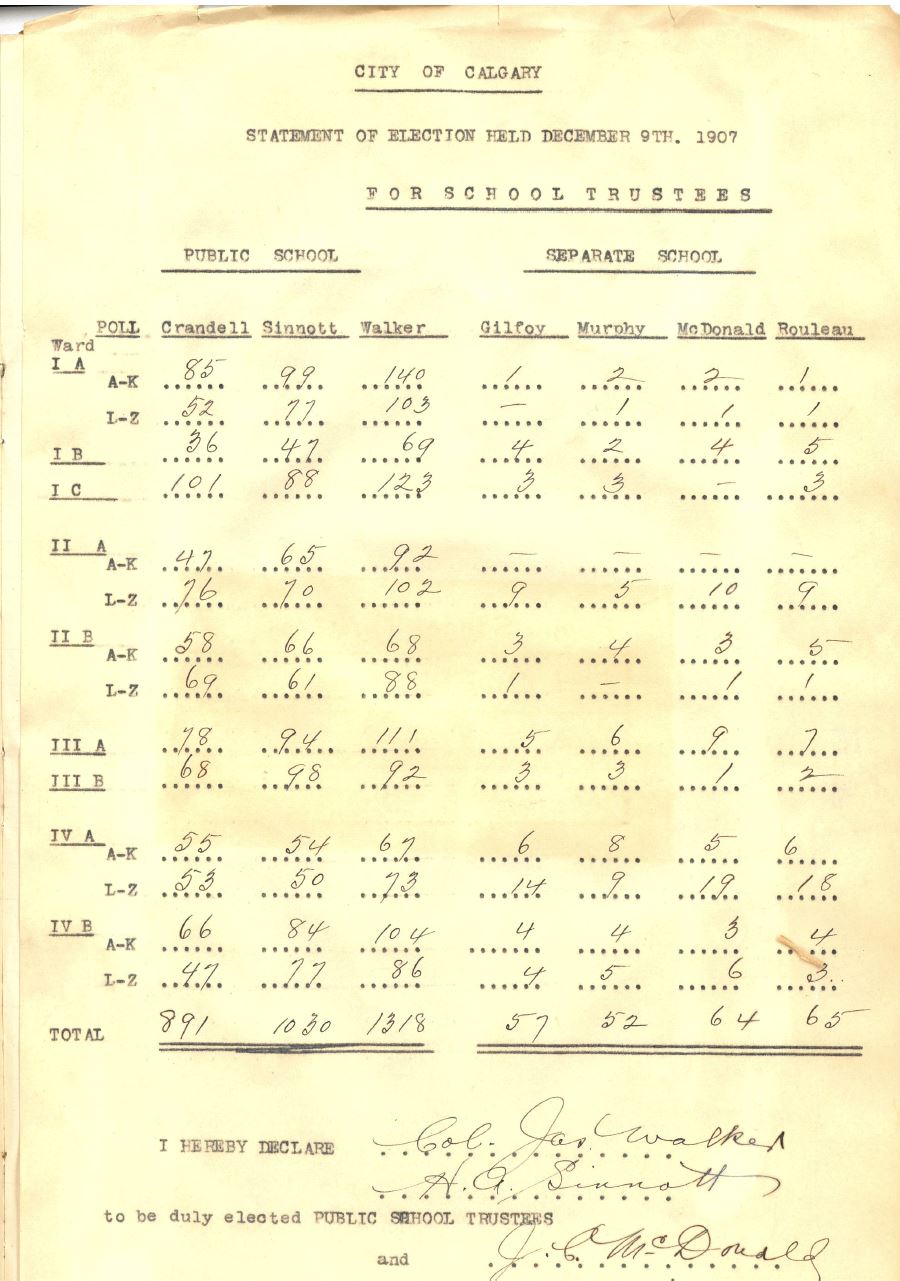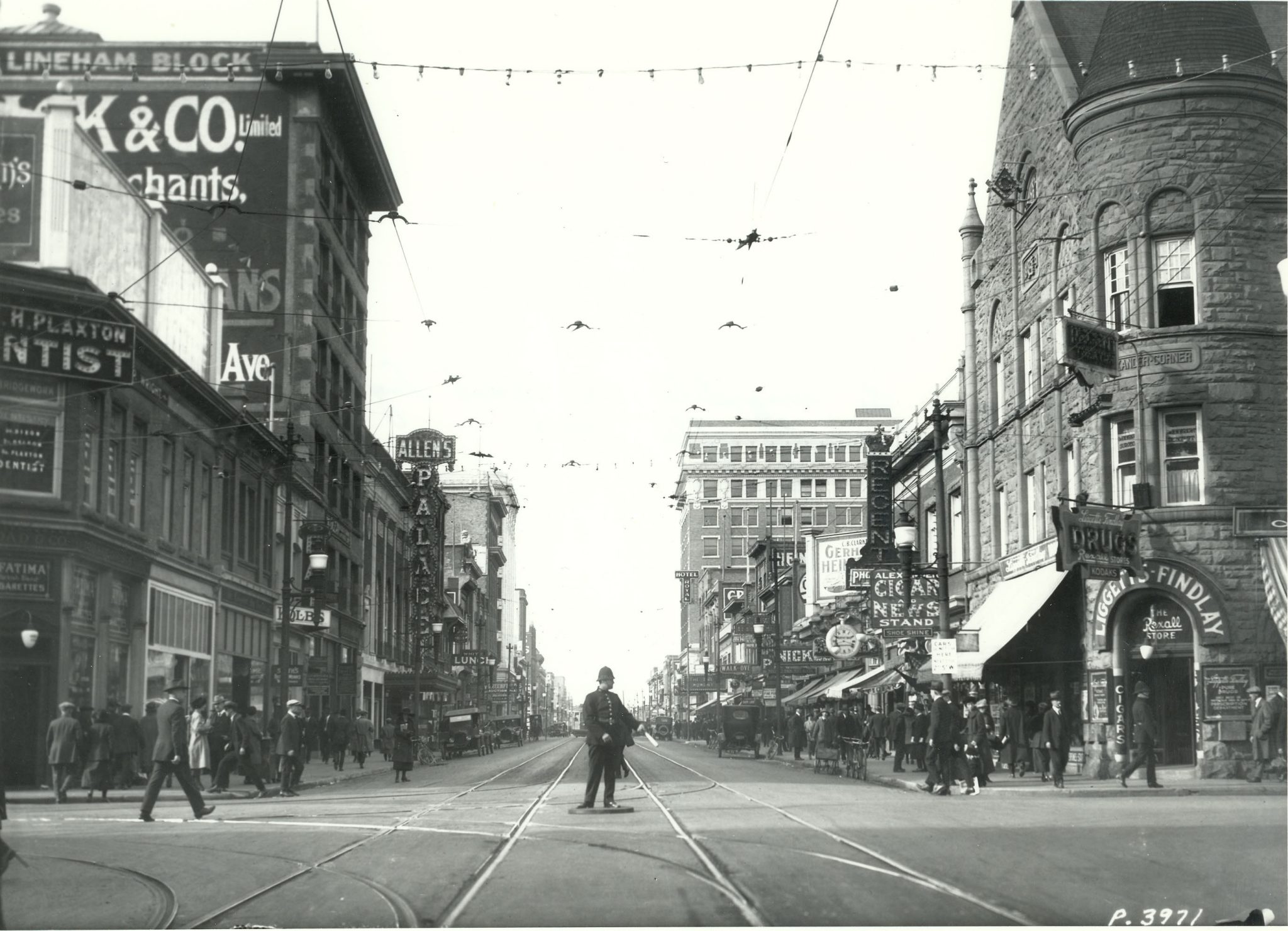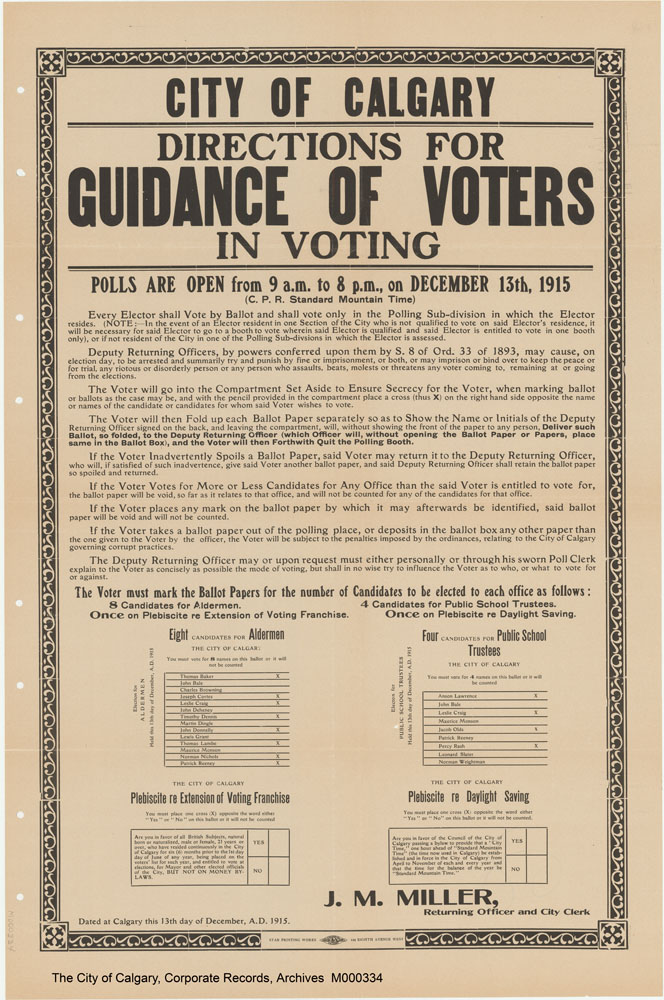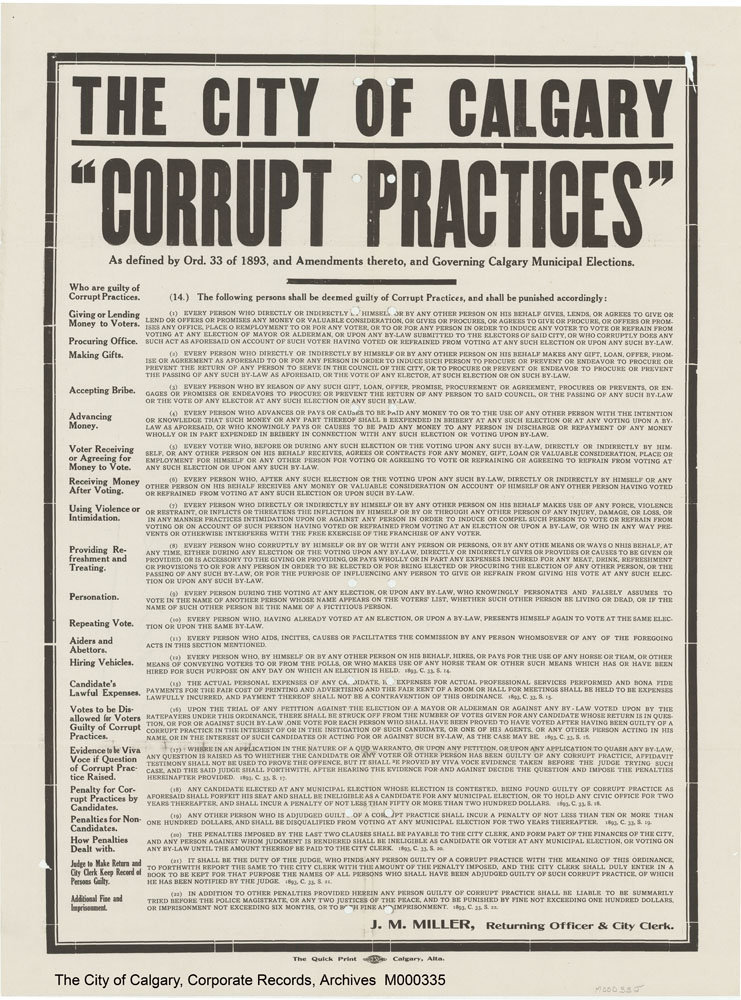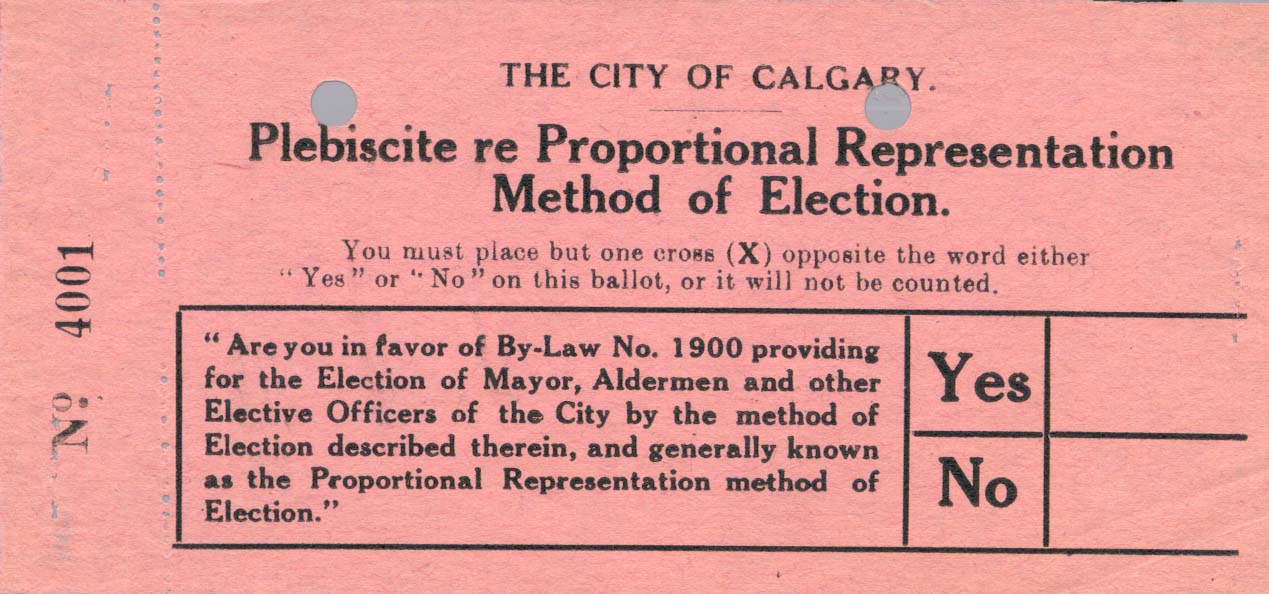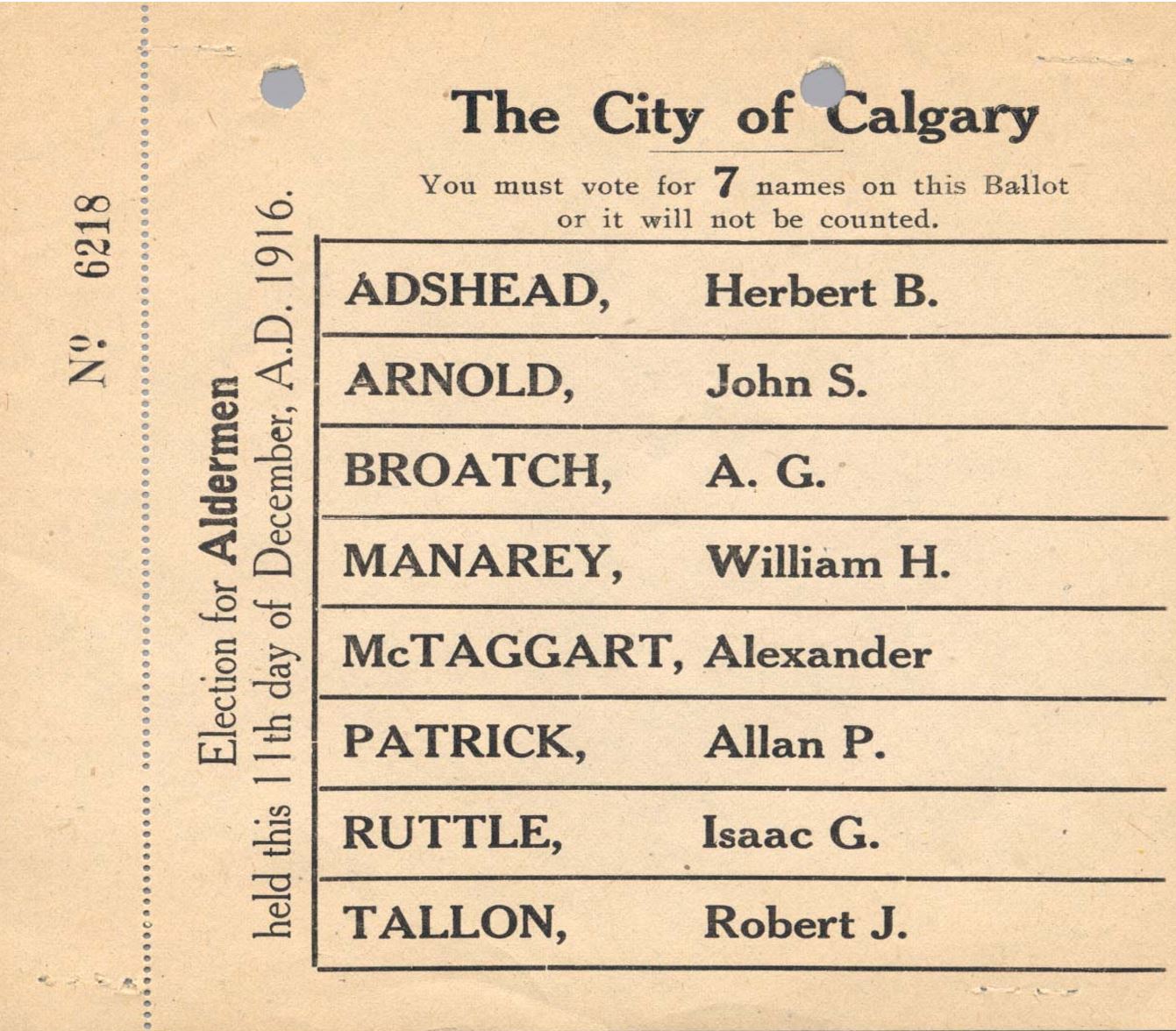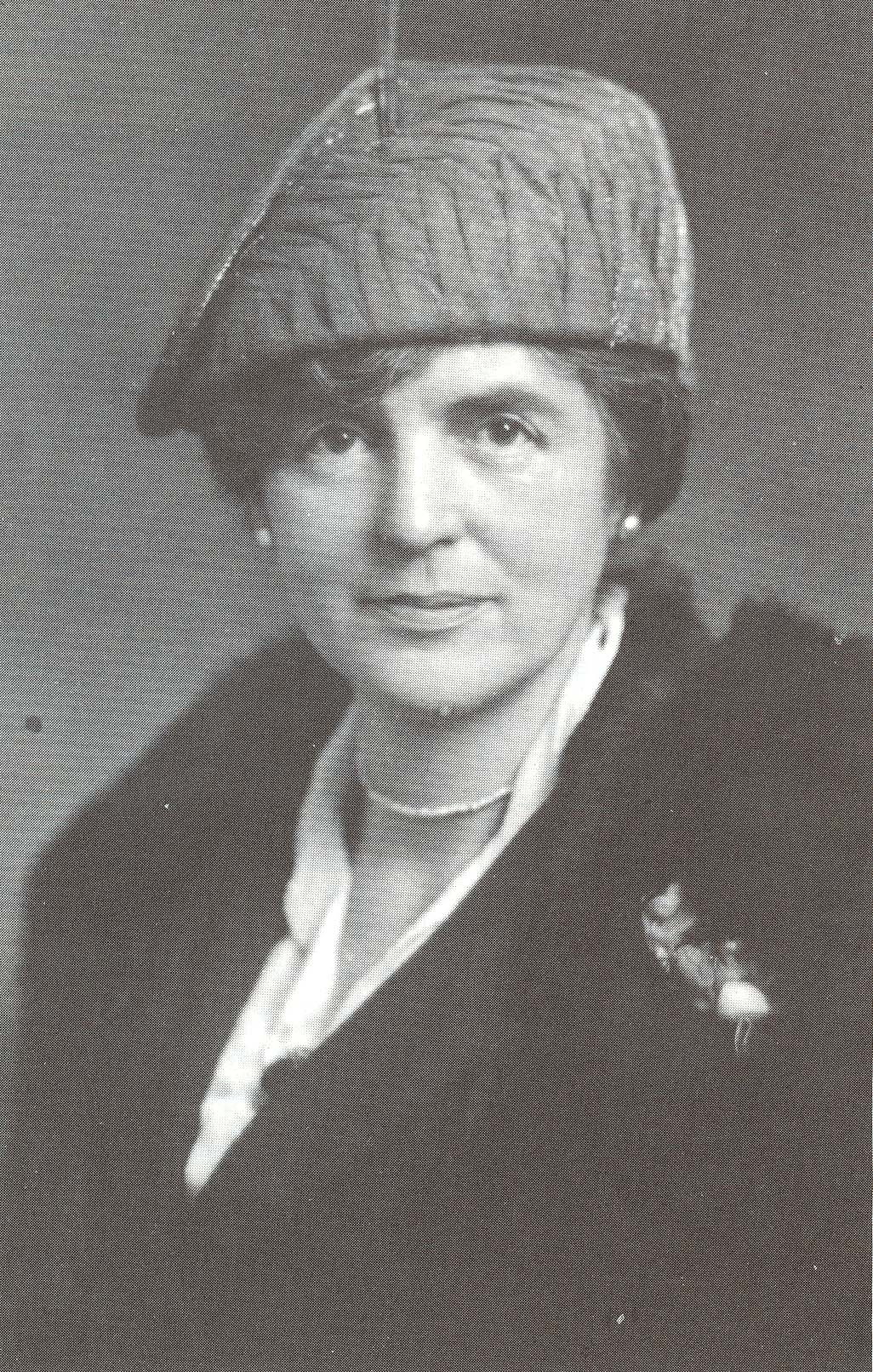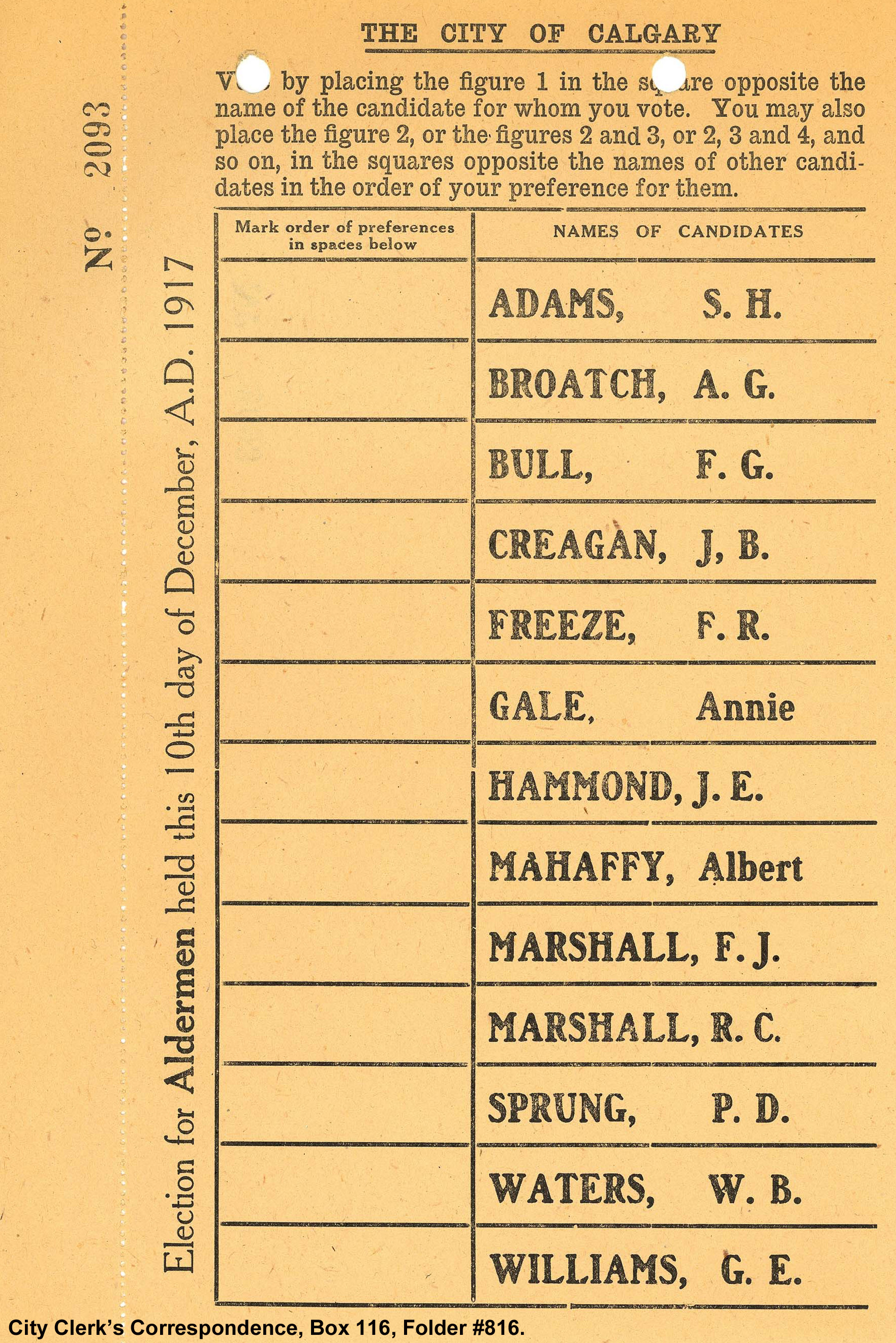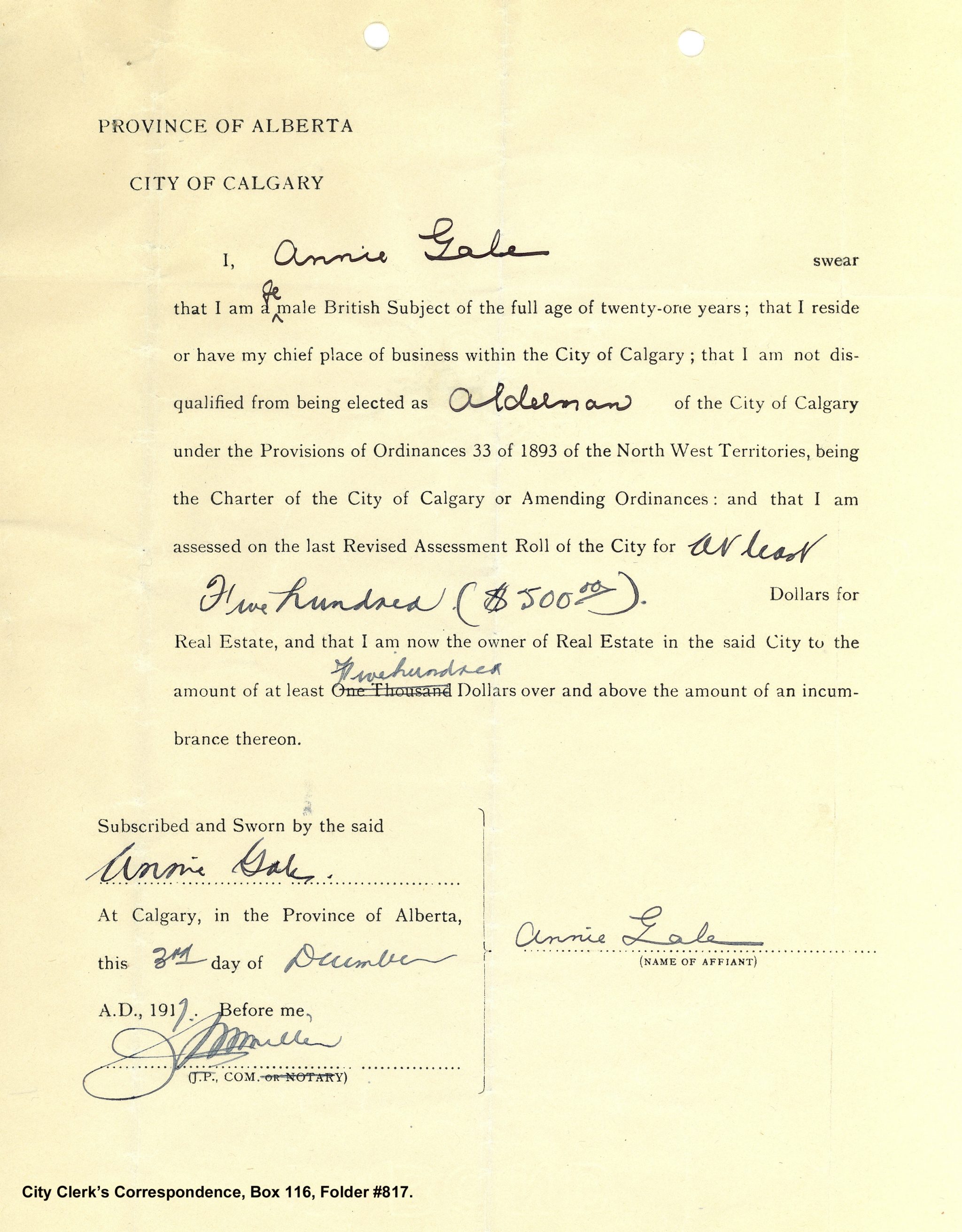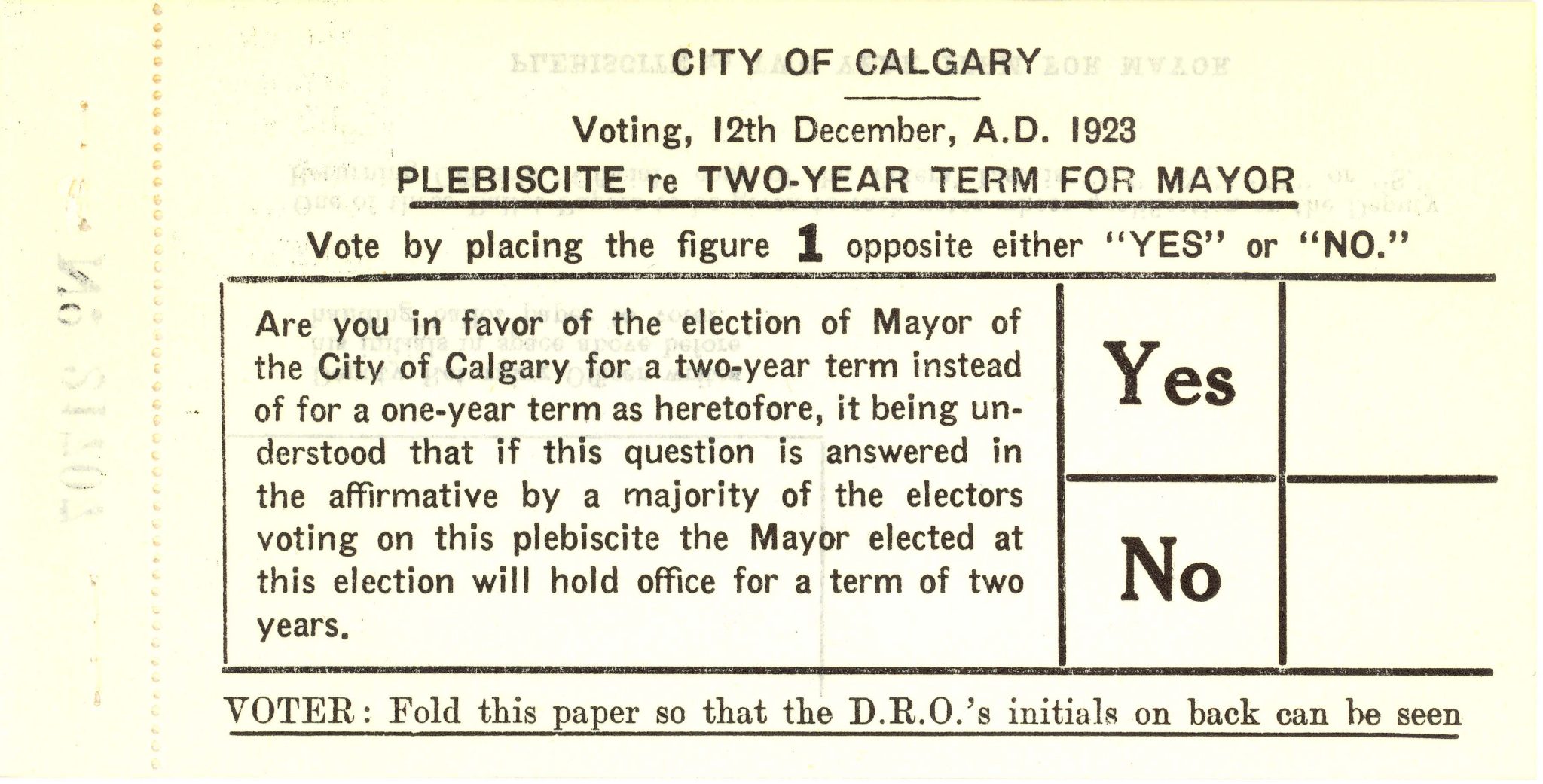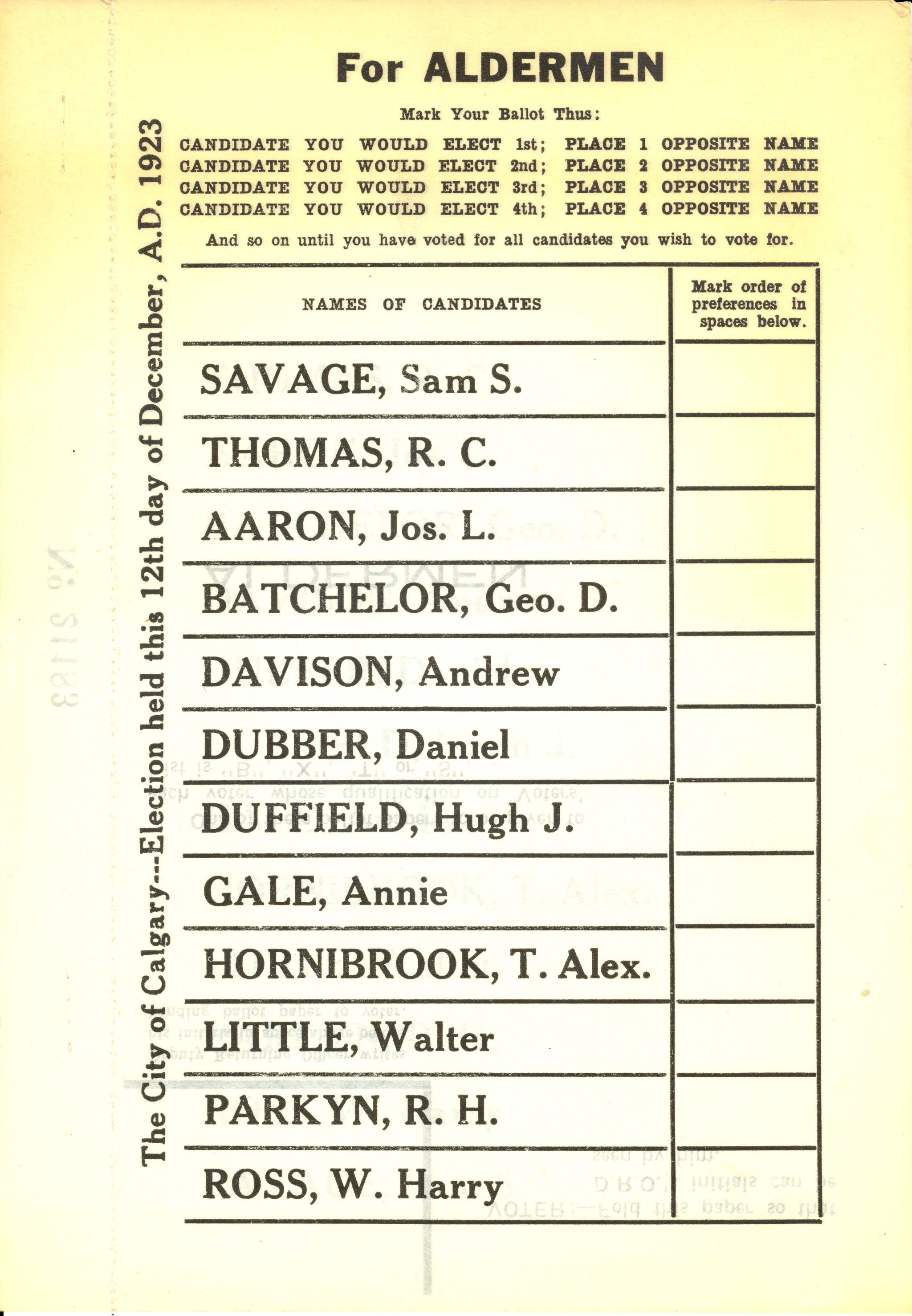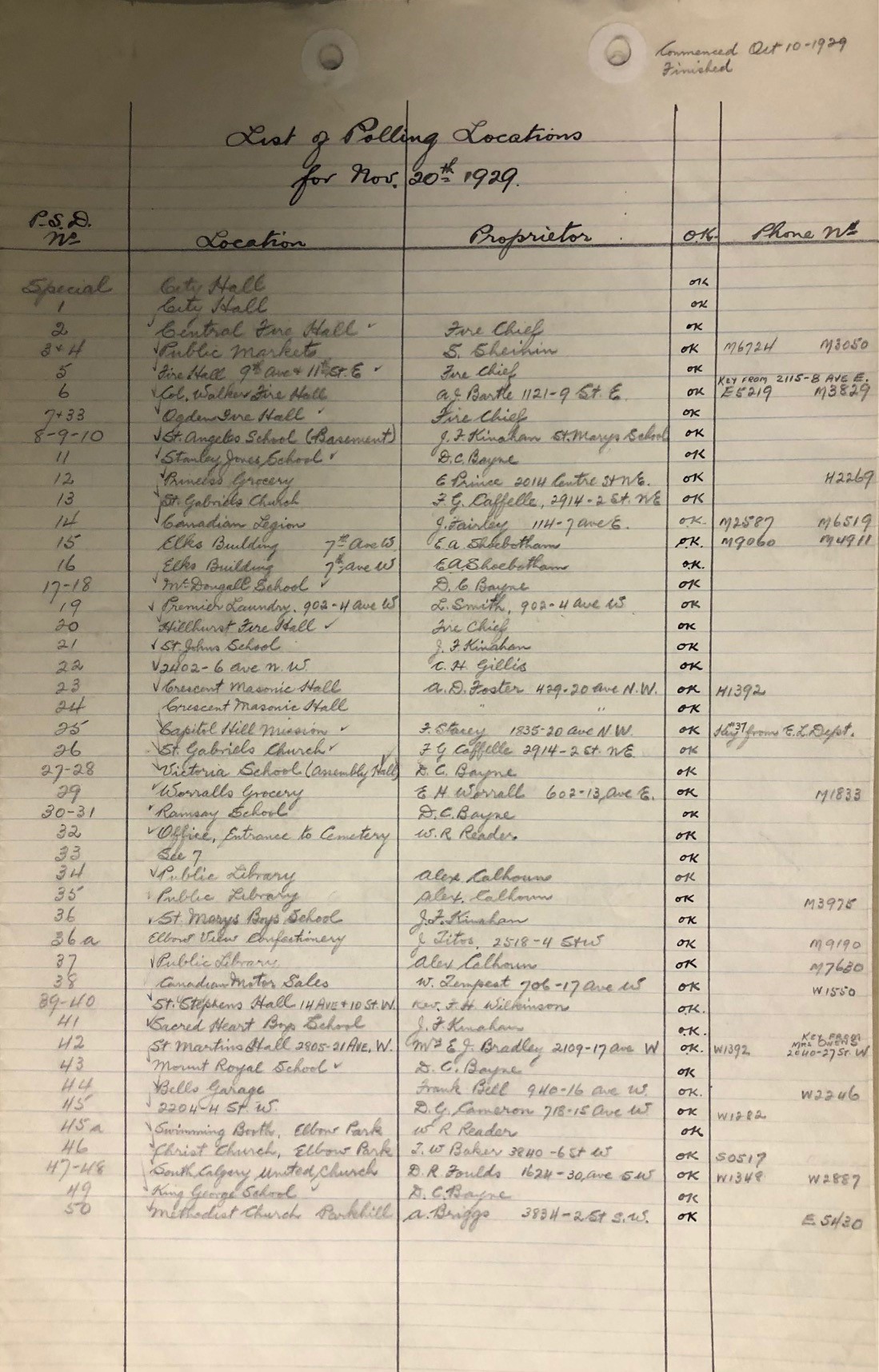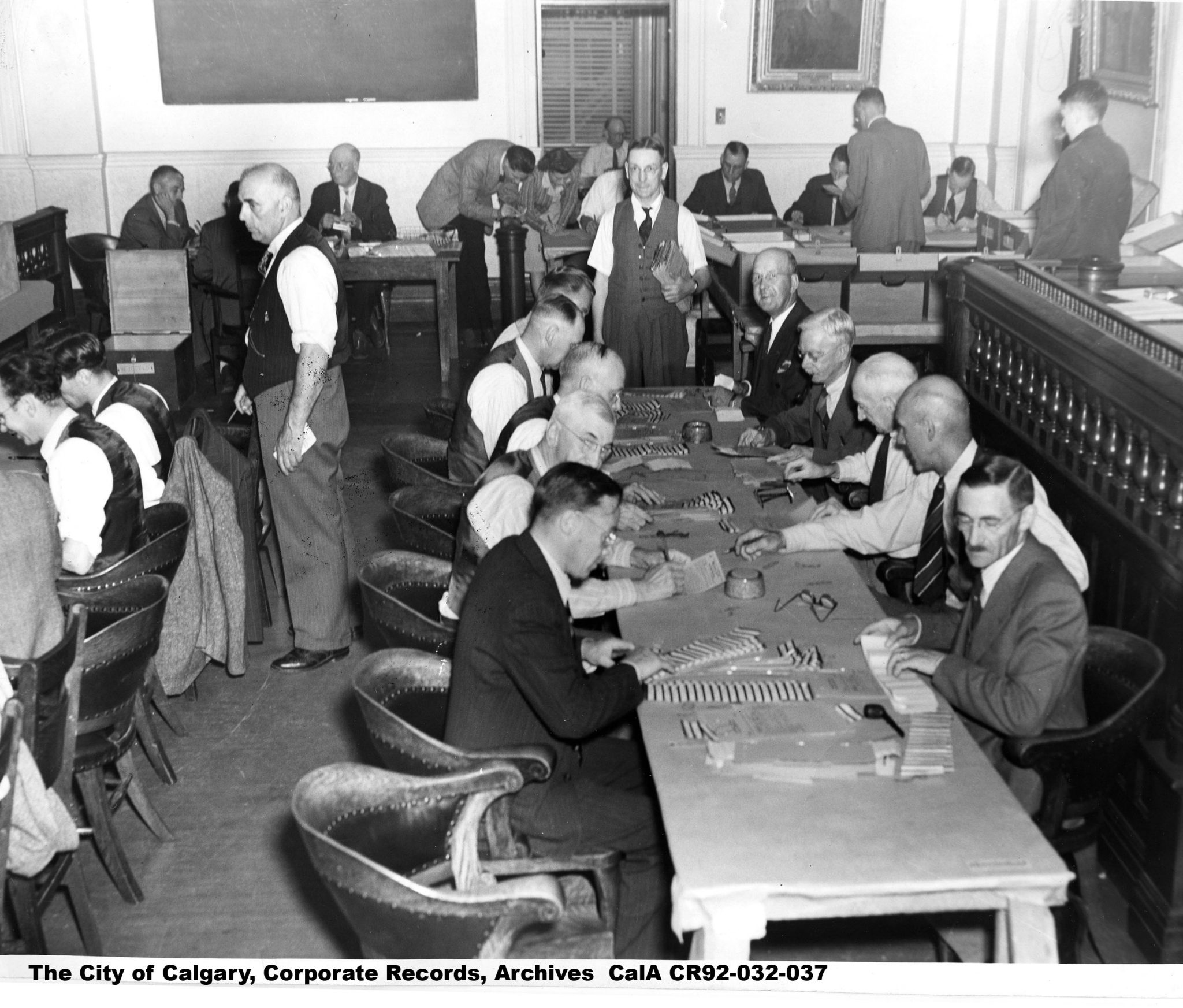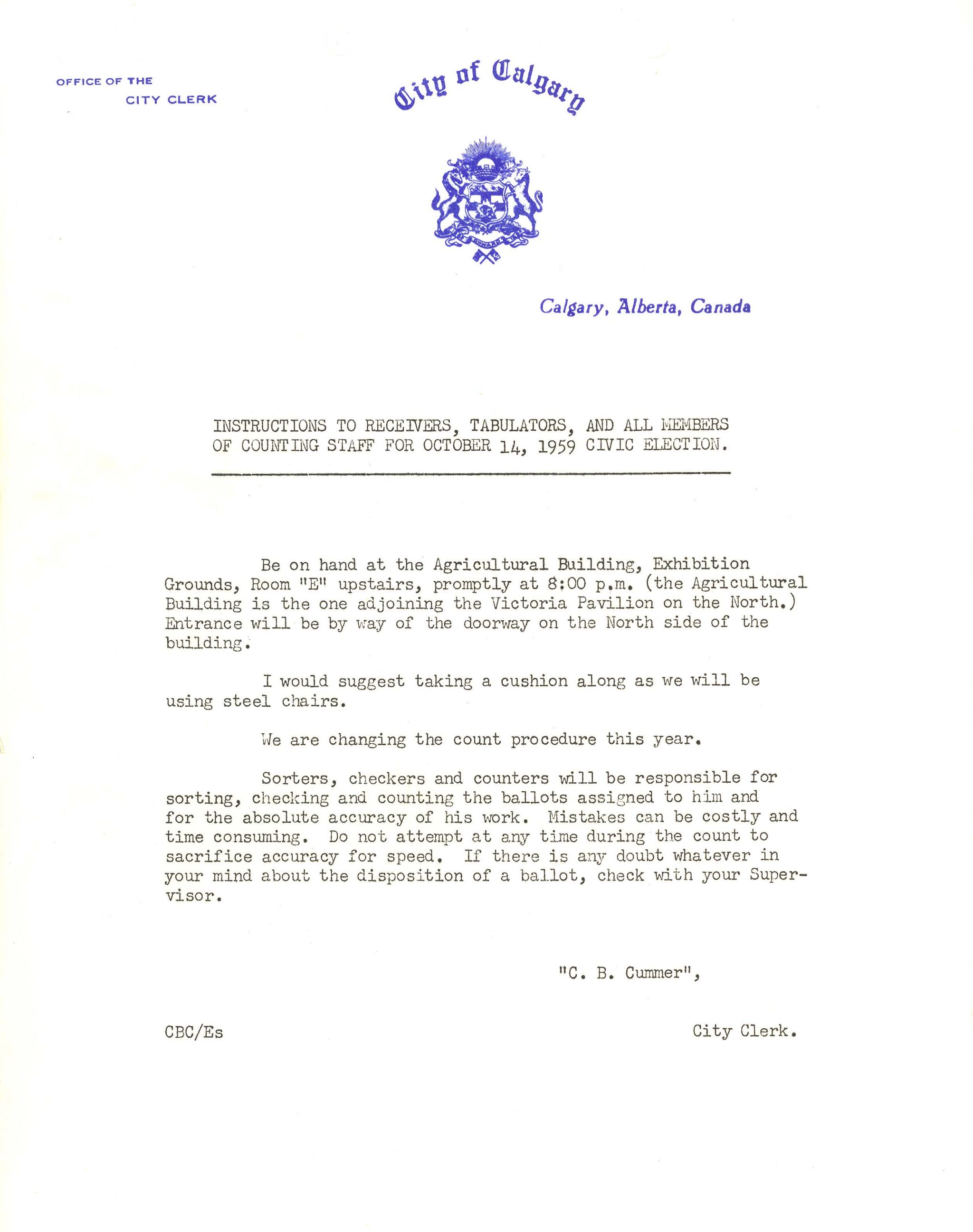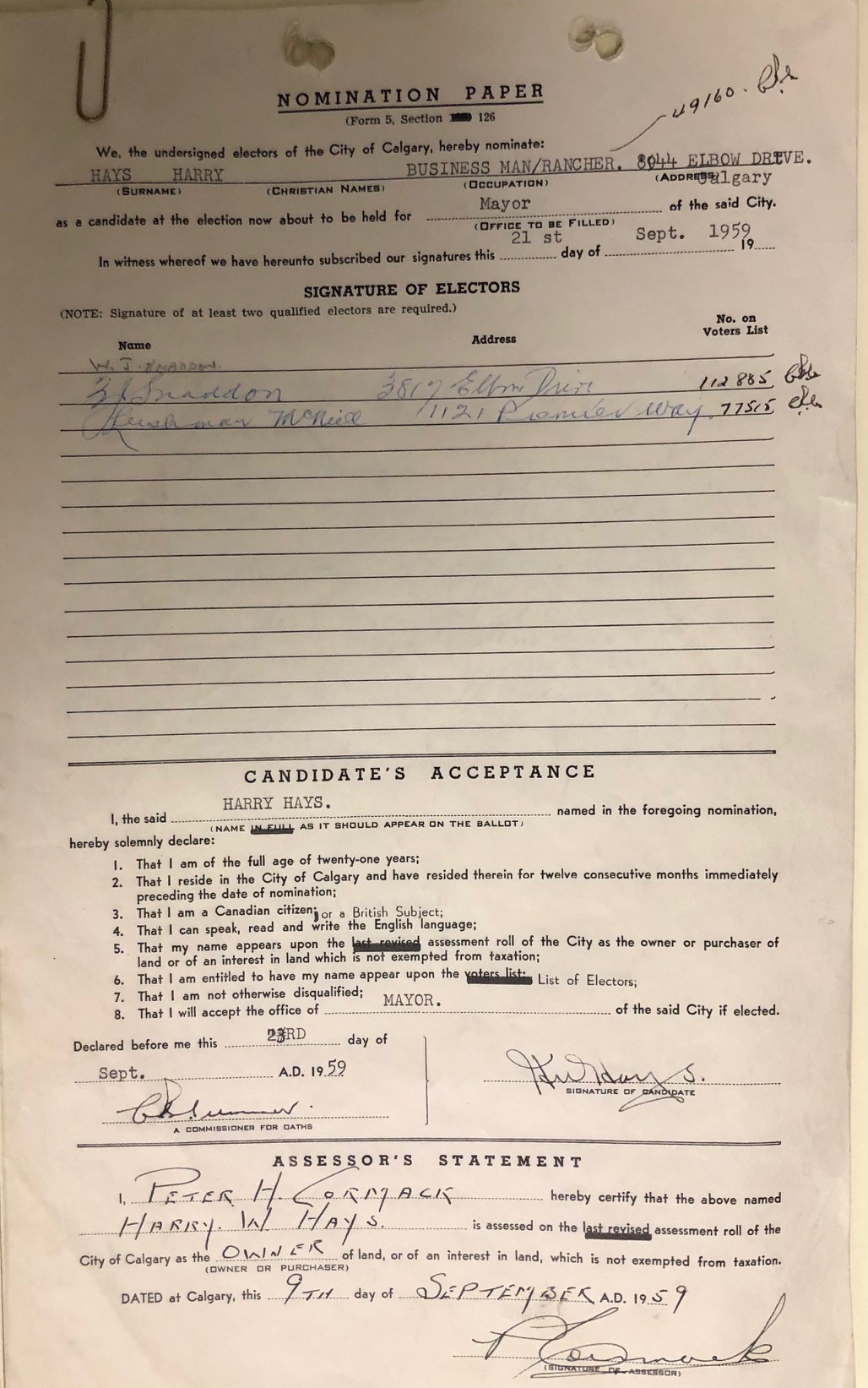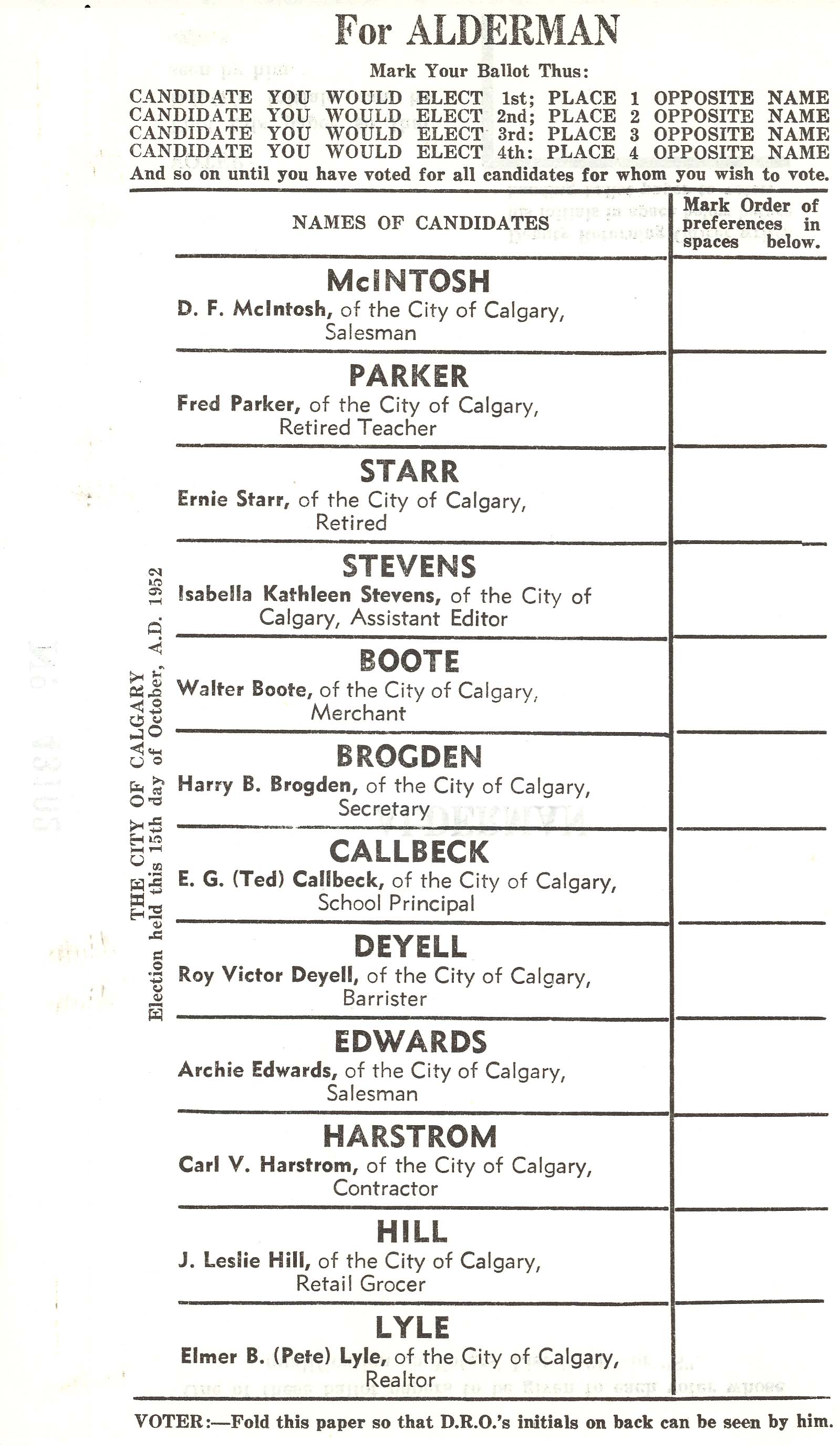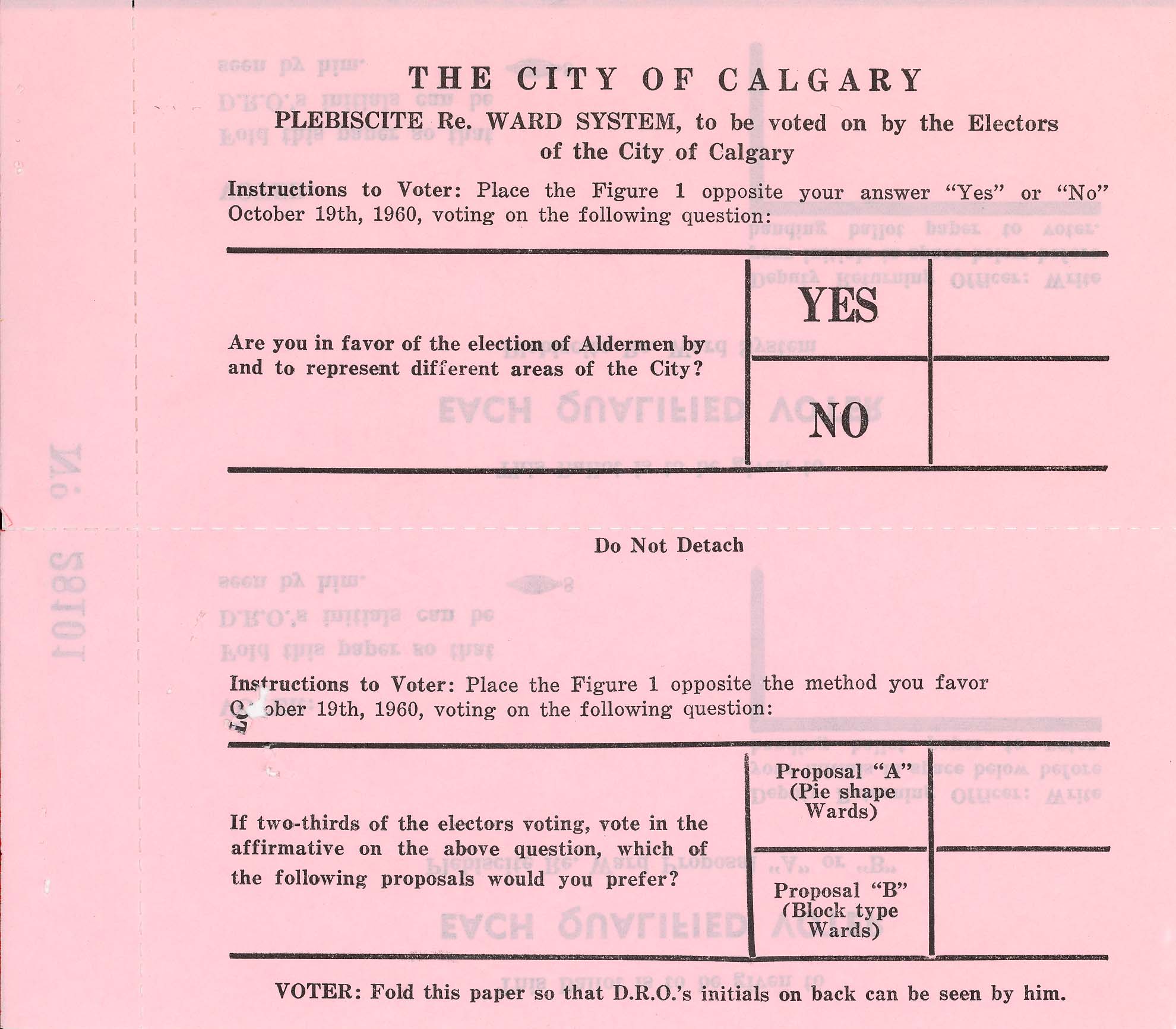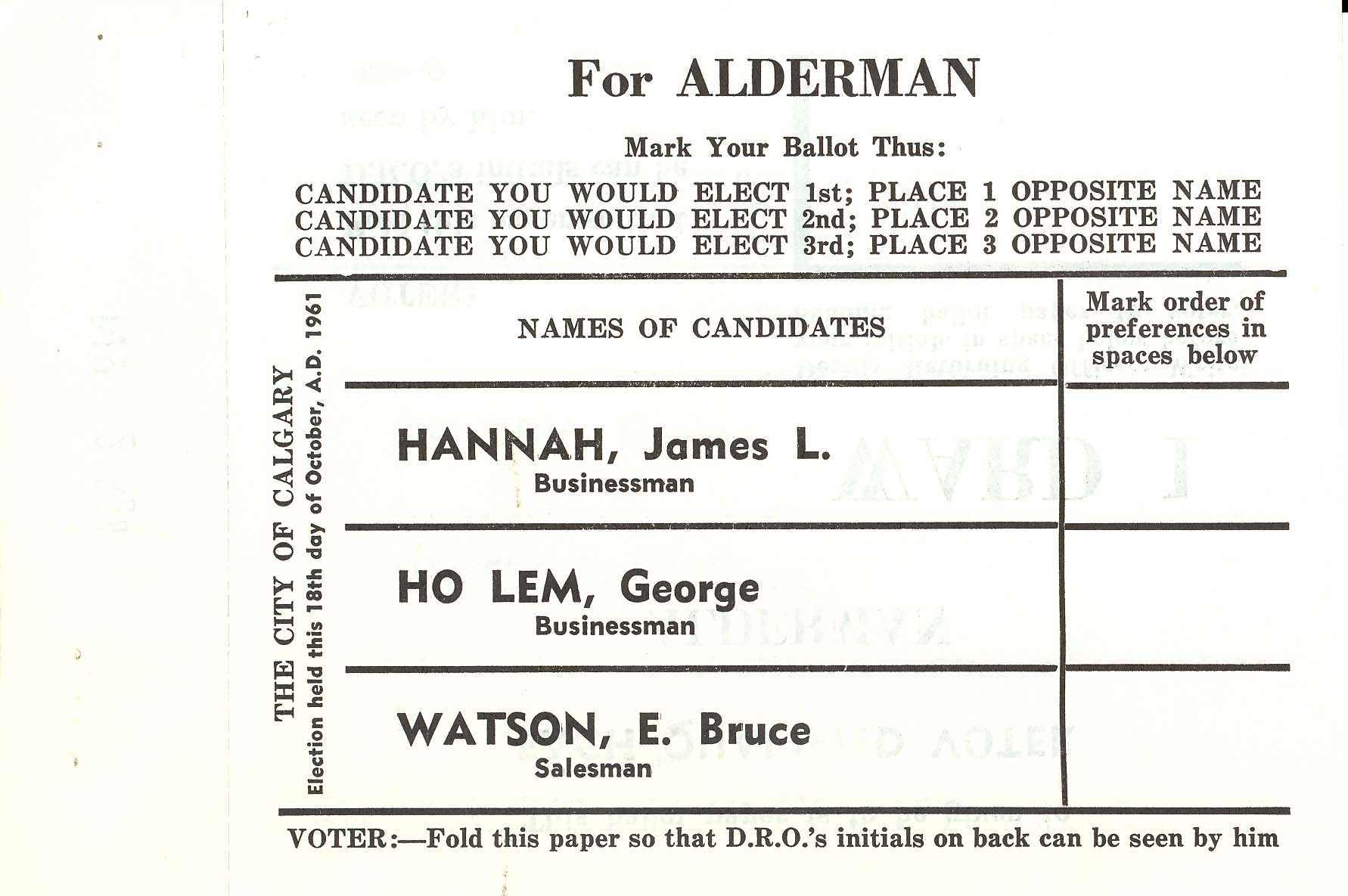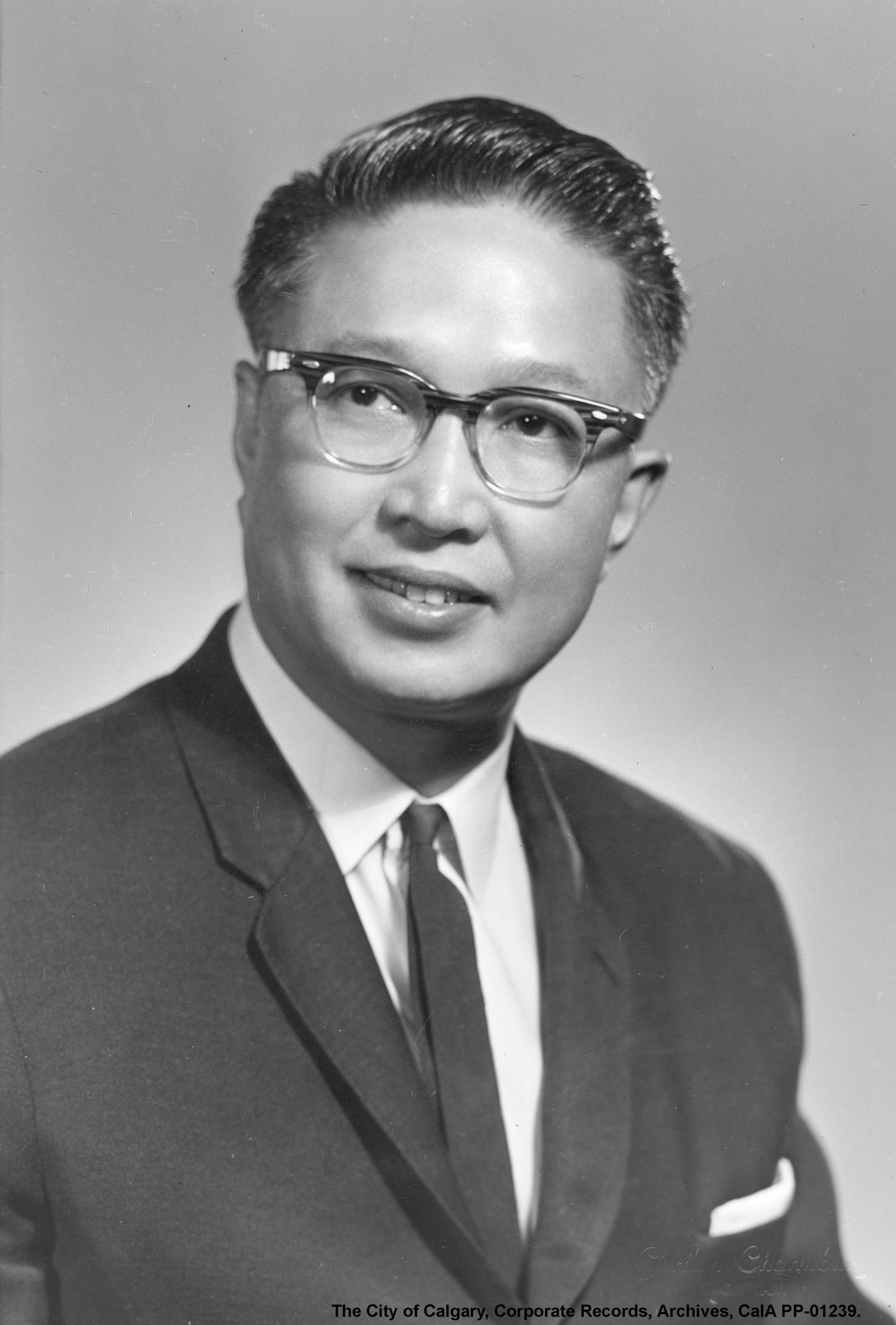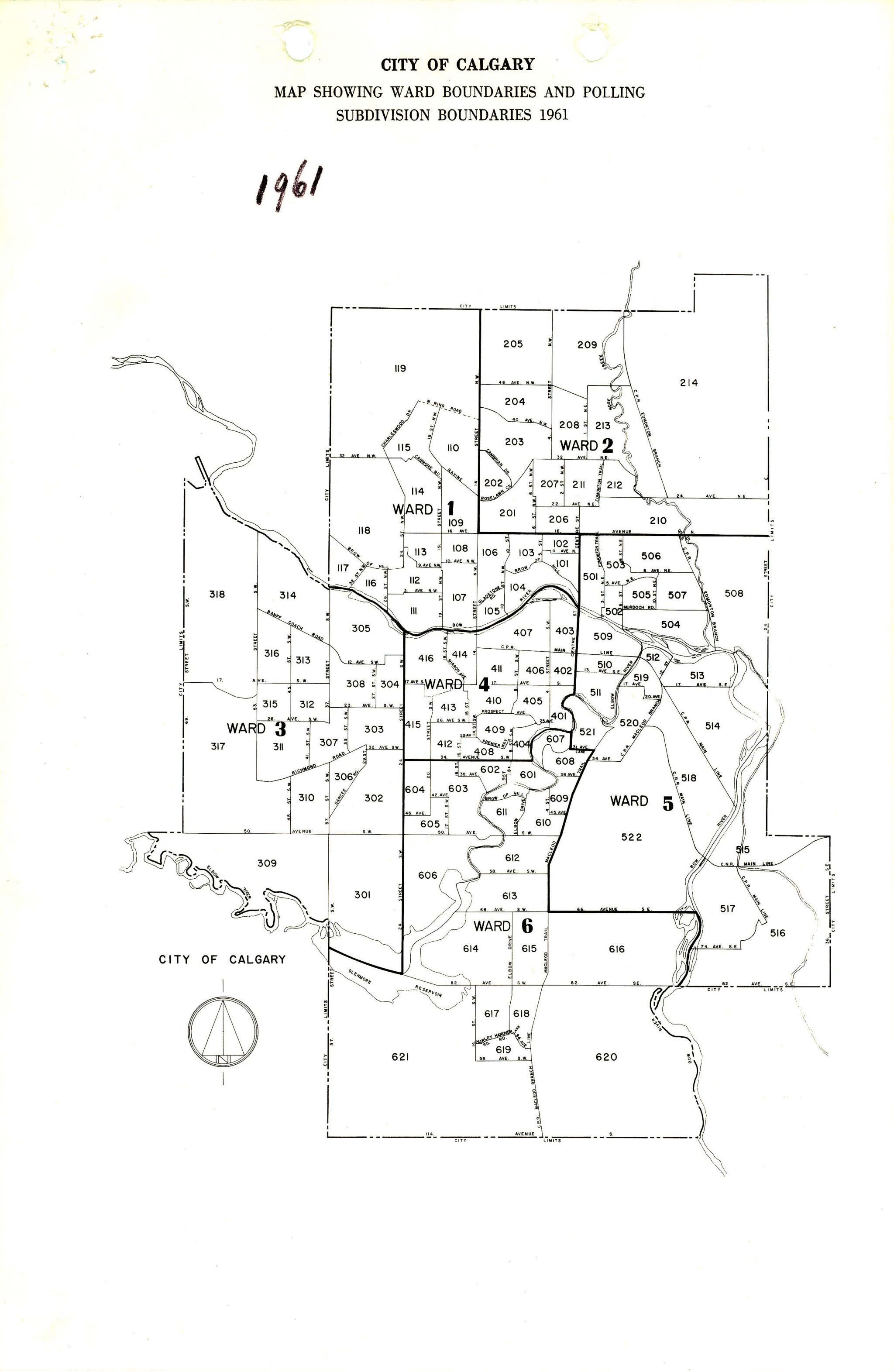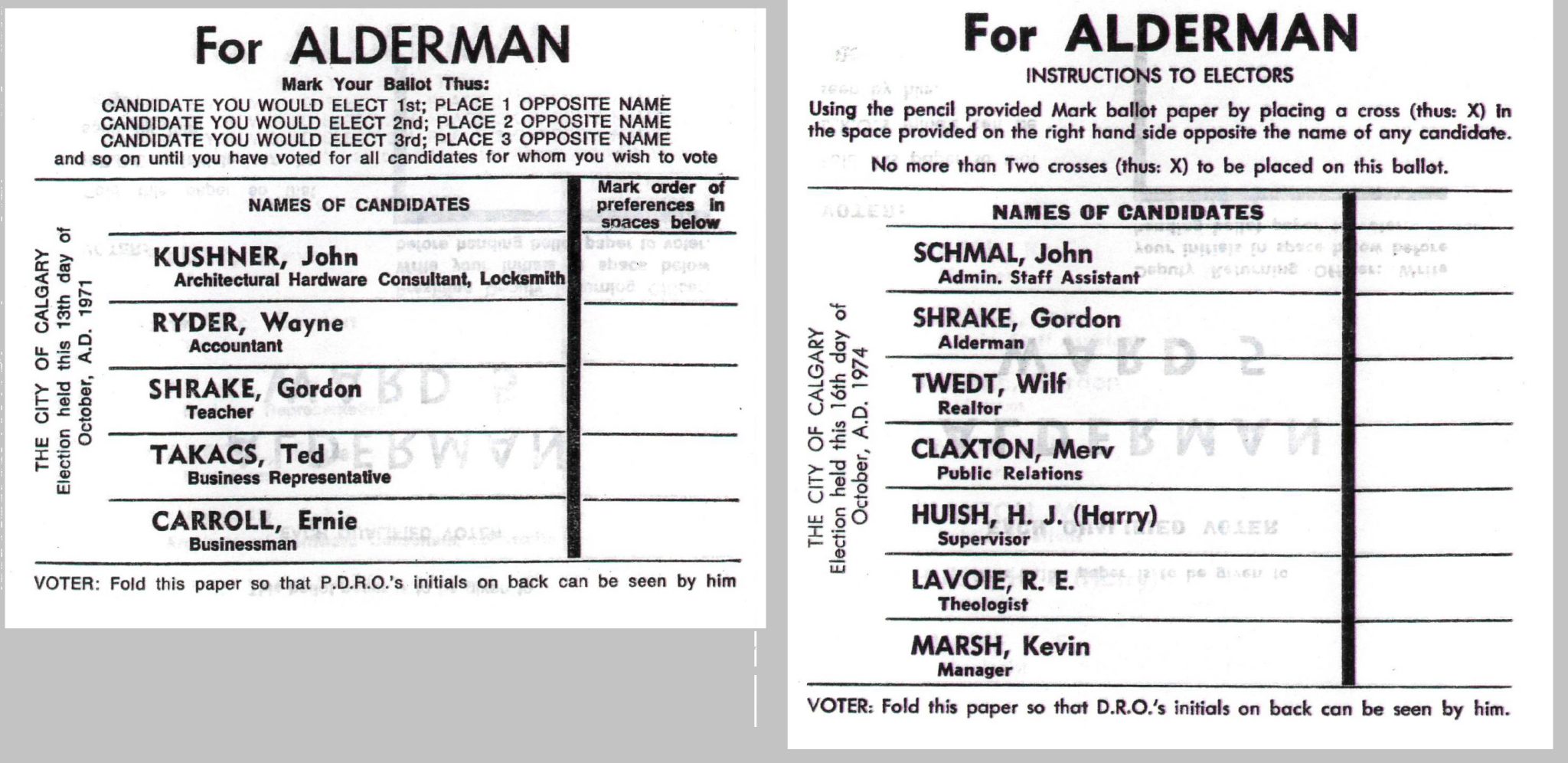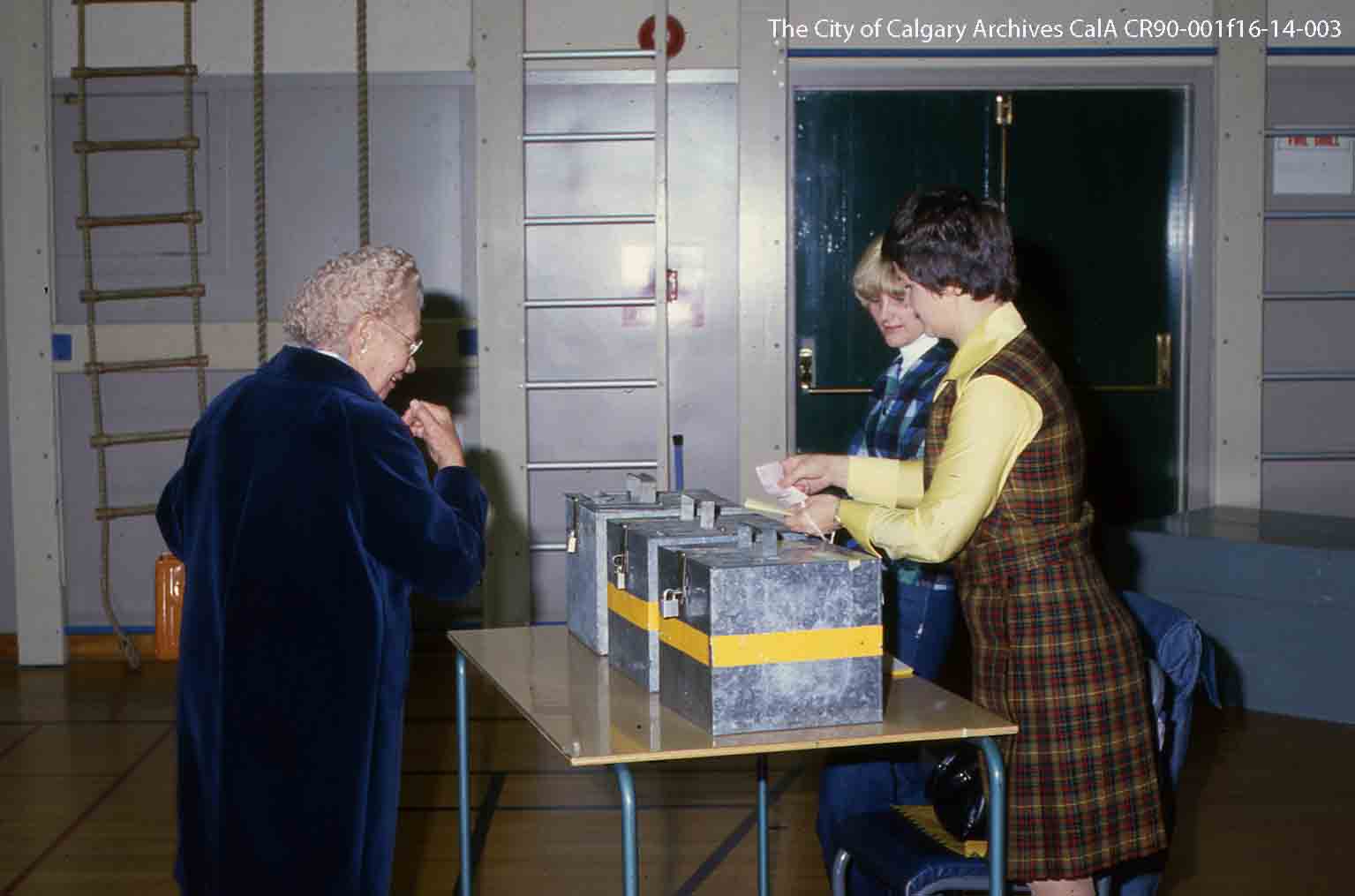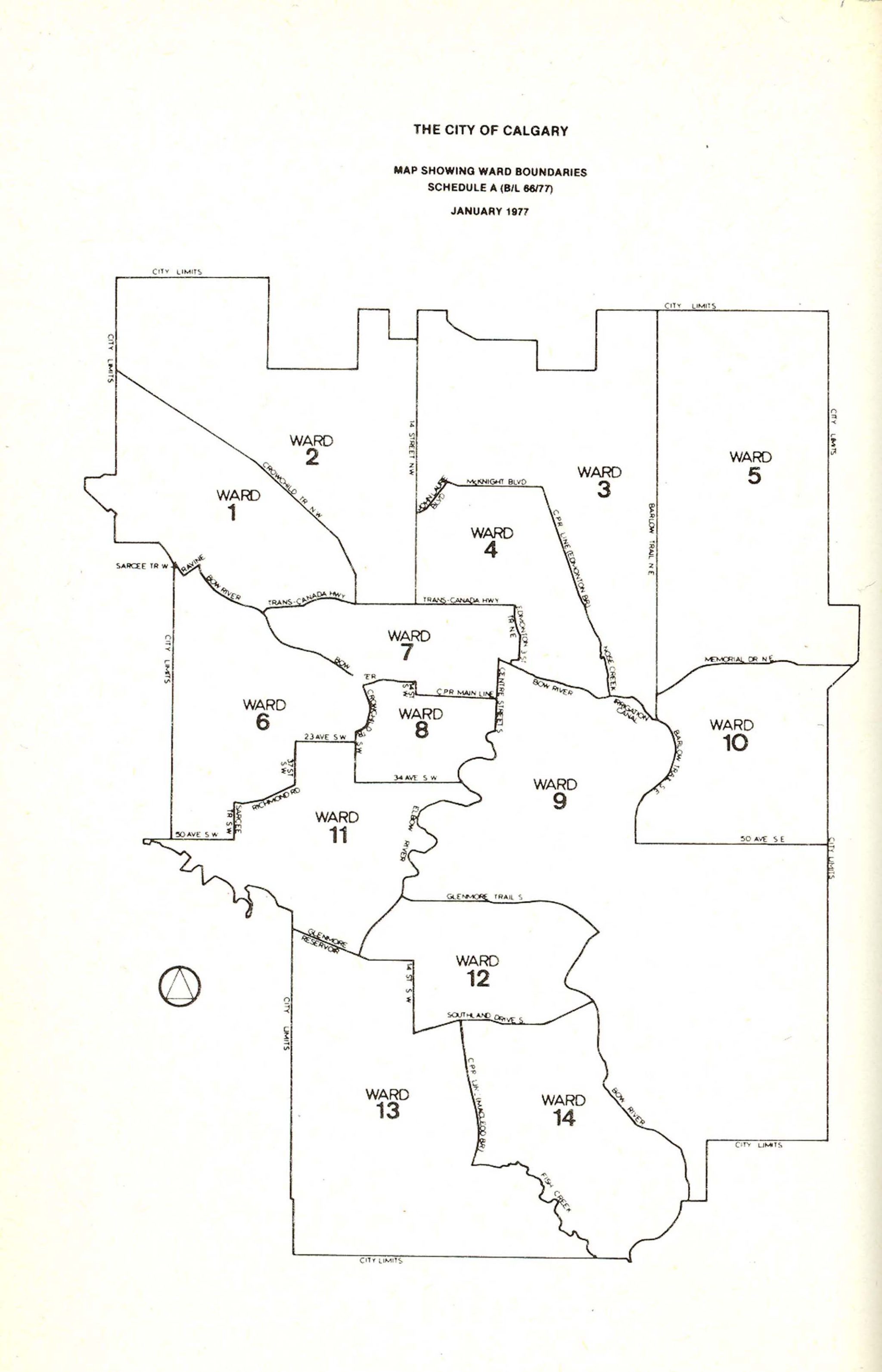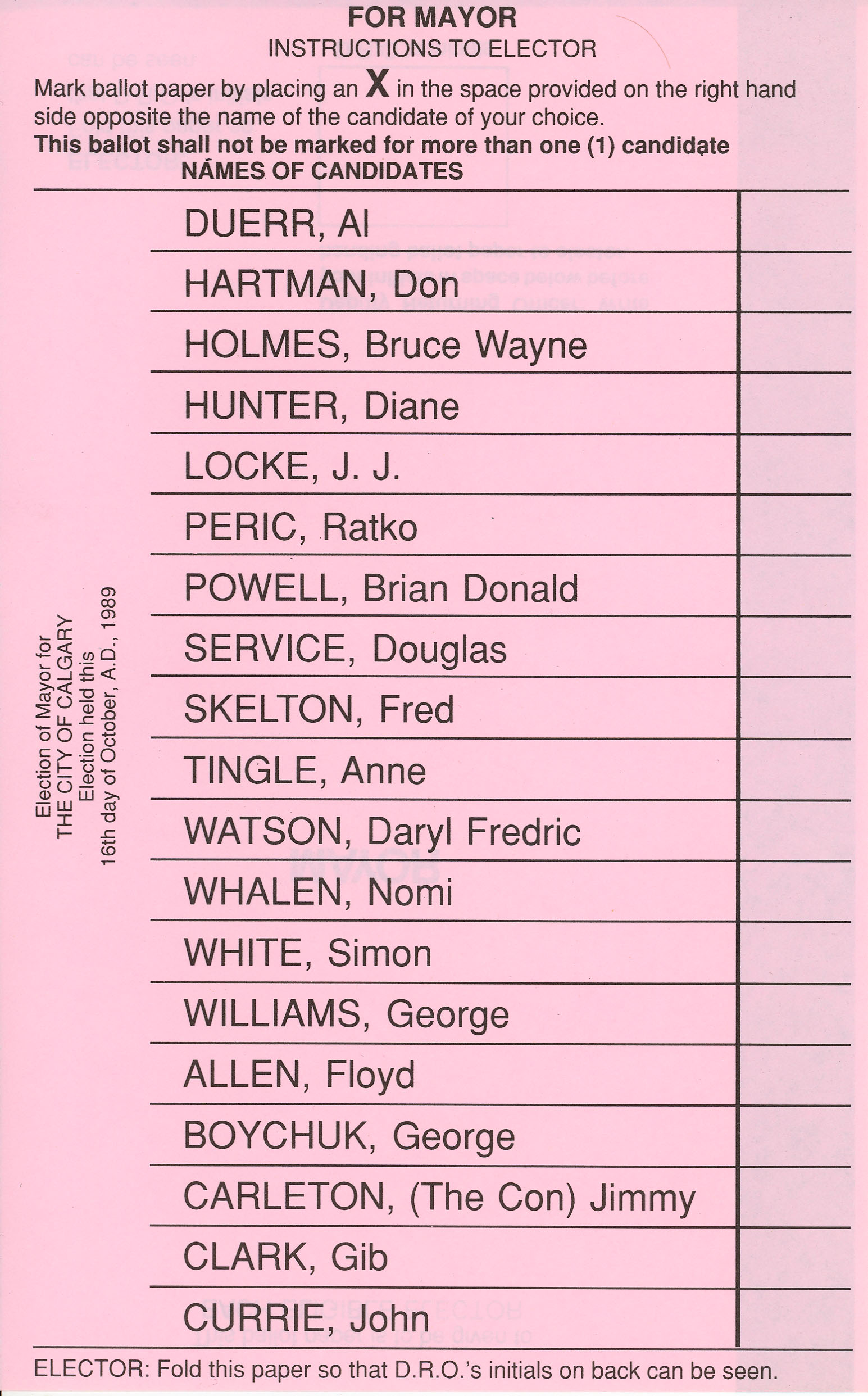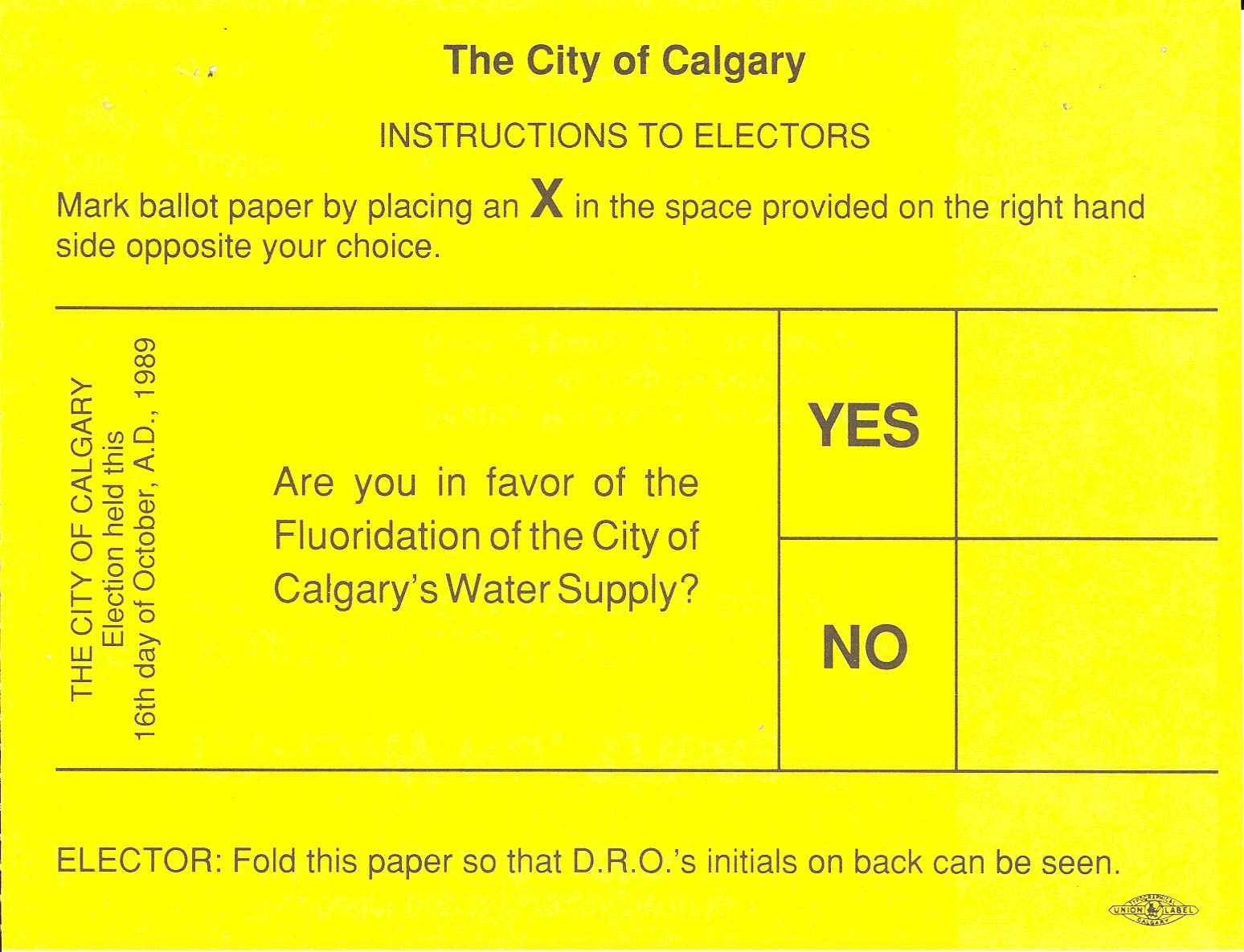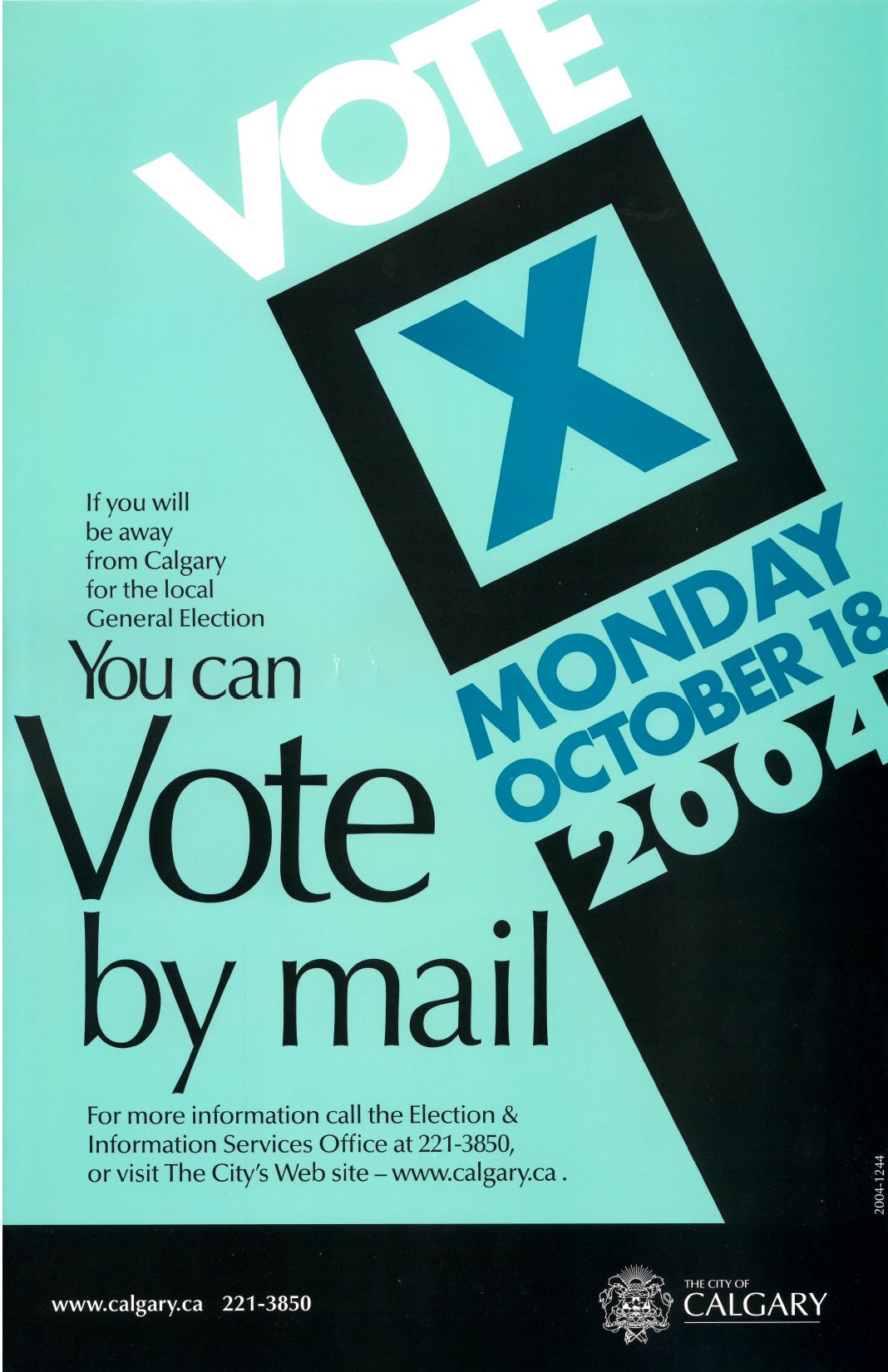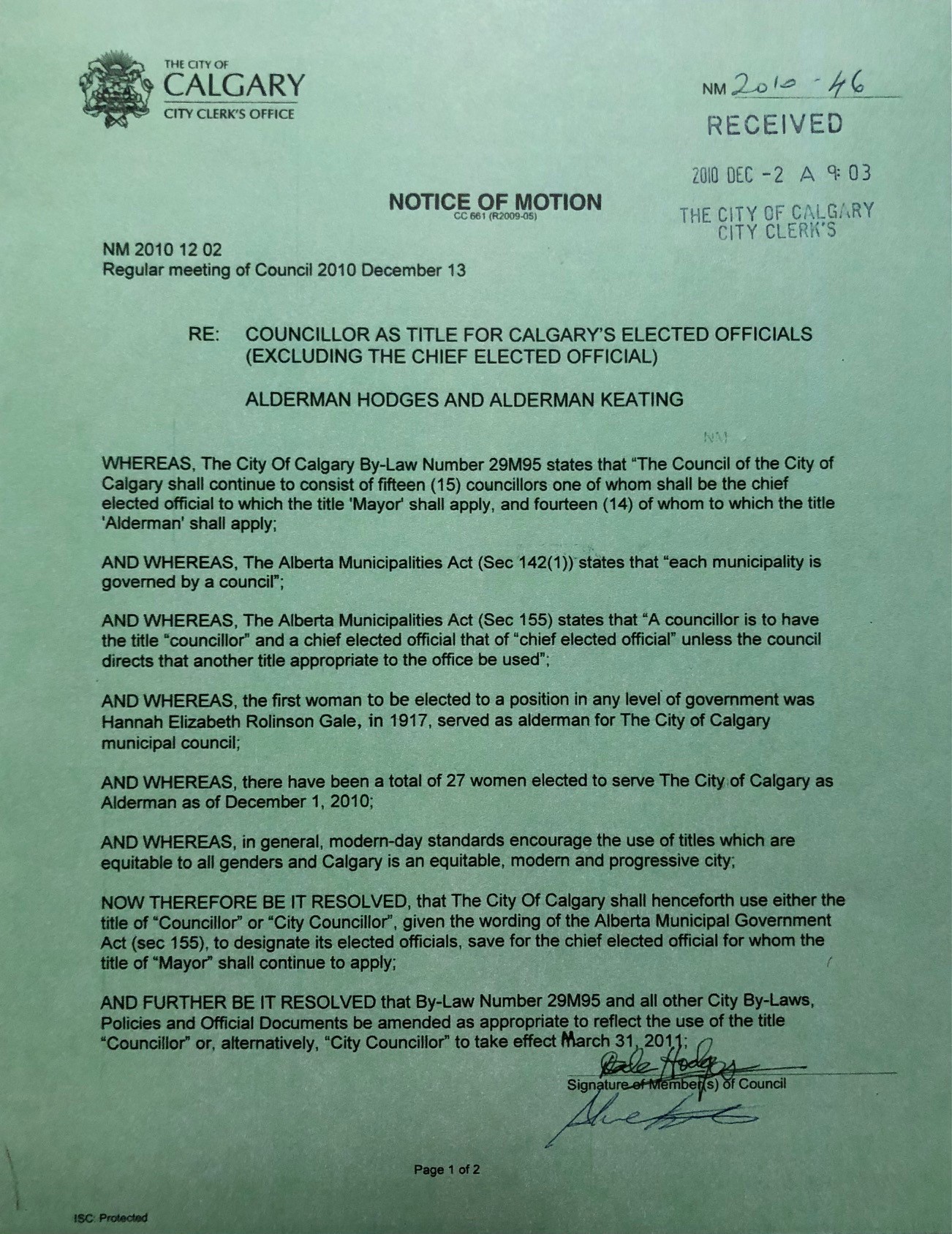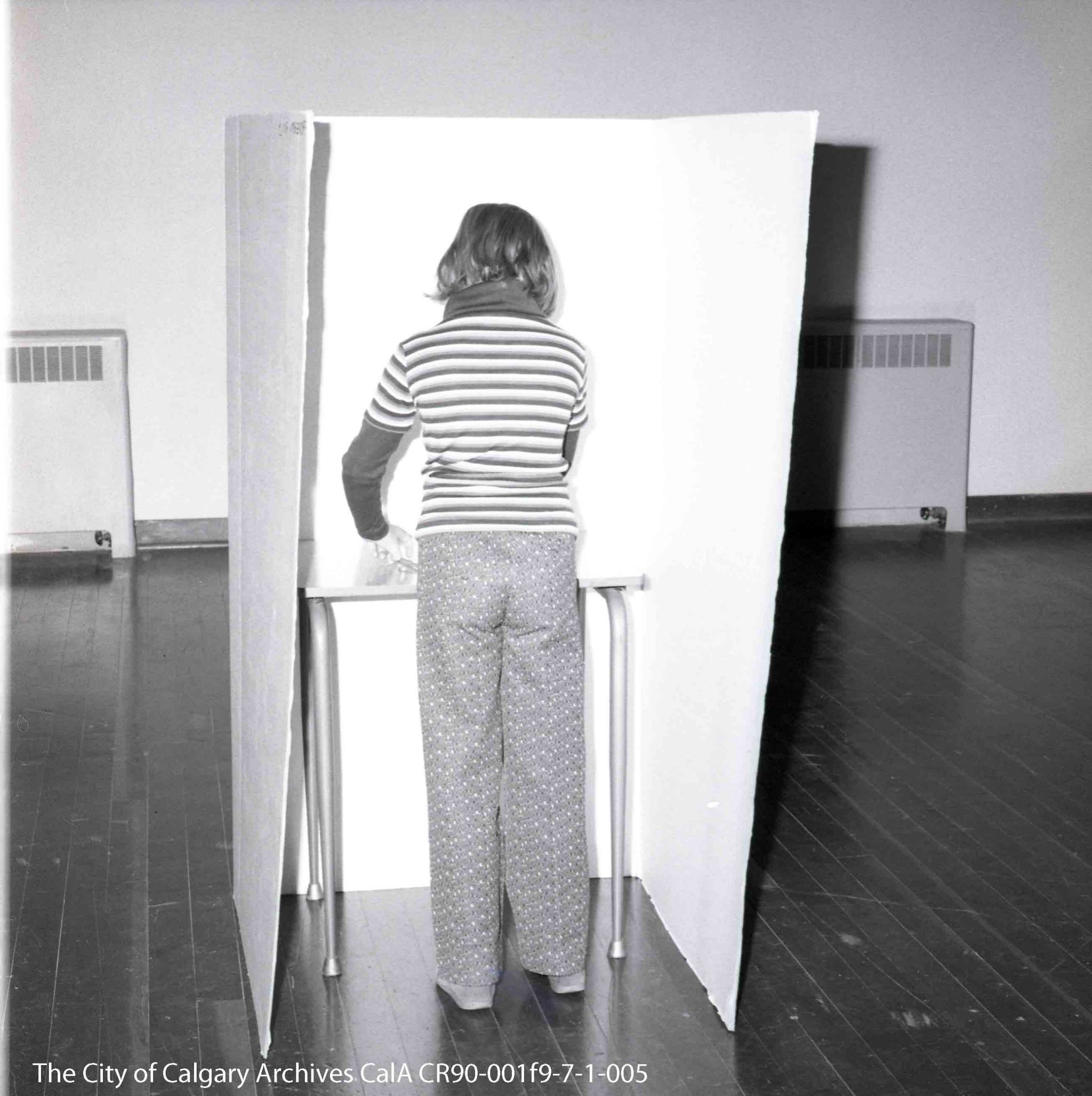Election Exhibit
Follow the evolution of municipal elections in the City of Calgary from the start of the Civic Committee, through the period of Proportional Representation and into contemporary electoral issues and voting modernization.
The Municipal Government Emerges 1883
Fort Calgary
In 1875, the “F” Troop of the North West Mounted Police crossed the Bow River and established Fort Calgary at the confluence of the Bow and Elbow Rivers. With the establishment of a Hudson’s Bay Company store, an I. G. Baker Company store, and the North West Mounted Police fort in 1881, Calgary soon had a population of 75!
Towards a Civic Committee
As Calgary continued to grow and reached a population of just over 500 people within the next couple of years, citizens recognized that many issues associated with this rapid growth would soon need to be addressed and pressed for municipal self-government.
James Reilly circulated handbills calling for a public meeting to discuss these and other civic matters. The meeting was held on January 7, 1884 at the Methodist Church .
During the meeting, it was decided to form a Civic Committee to watch over the interests of the public.
Notice of the Civic Committee Election
On January 8, 1884, citizens reconvened and agreed to nominate a committee of seven to be elected by ballot on January 14, 1884.
Twenty men were nominated at this meeting and their names were included on the broadsheets posted around Calgary that announced the election.
Calgary’s first civic election, to appoint a representative Civic Committee, was held on January 14, 1884 in Wright & Latmer’s Hall. Of the 24 candidates who put their name forward, the top seven candidates were elected.
Town Requirements
One of the first acts of the Committee was to approach Lieutenant- Governor Dewdeny to determine the requirements for incorporation as a town. A four-man committee was appointed to collect the census and petitions required for Calgary’s application for incorporation as a town.
Incorporation of Calgary as a Town
First Municipal Election – December 3, 1884
The Town Council
Once incorporated, The Town of Calgary was subject to the Northwest Territories’ Ordinance Respecting Municipalities, No. 4 of 1884. One of the stipulations in the ordinance was to hold an election for a mayor and four councillors.
After issuing the proclamation of incorporation, the Lieutenant-Governor was to appoint a returning officer to hold the first election. The ordinance provided detailed regulations for conducting an election.
Any resident of the municipality was entitled to vote at the first election, if they were a male British subject over 21 years of age and a freeholder (or householder) for a period of at least three months prior to the election.
Any person residing in the municipality and qualified to vote at the first election, and not otherwise disqualified under the provision of the ordinance, was eligible for election. November 26, 1884 was nomination day for mayor and councillors.
First Mayor of The Town of Calgary
The first Municipal General Election was held on December 3, 1884 and four councillors and the mayor were elected at large from the town of Calgary for approximately a one-year term.
The first Town Council had its initial meeting on December 4, 1884 and appointed their first public servant, Thomas T.A. Boys as Town Clerk by resolution. This appointment was later confirmed by By-law 30 in May 1886.
Schism of 1886
Schism
Split Councils
From January to October 1886, there existed a rival faction claiming to be the legitimate Council. It’s what became known as the Council Schism. This so called “minority council” or “anti-council” was installed by arbitrary order of the local Stipendiary Magistrate who had declared the incumbent Mayor and two of his councillors disqualified from re-election.
In The Calgary Herald on Febuary 27, 1886, it was noted that the “minority council” had “thrown municipal matters into confusion by assuming position to which they were never elected… [the miniority council] has made it impossible for the great mass of voters to decide in their own minds who the legal council are. The resignation of one side would not however make the other a legal council.. In the near future we think it probabble both sides may resign in order that there may be a new election, but this will not happen until the Government been induced to look into the cause of the trouble.”
Ordinance Respecting Municipal Matters
As a result, An Ordinance Respecting Municipal Matters In The Town Of Calgary (No. 1 of 1886) was passed on October 21, 1886, whereby it was declared that "no Council of the Municipality of the Town of Calgary exists, [and]…immediately, or as conveniently as possible after the passing of this Ordinance, the Lieutenant-Governor shall issue his Order for the election of a Mayor and four Councillors".
Becoming The City of Calgary 1893
Sealed
Calgary was incorporated as a City on September 16, 1893. The Charter for The City of Calgary was assented to and was referred to as No. 33 of 1893 An Ordinance to Incorporate “The City of Calgary.”
Town Council to City Council
Members of the Town Council automatically became members of City Council on January 1, 1894 when the new City Charter came into effect. Since elections were held yearly, Council members submitted their resignations shortly thereafter to ensure that elections for City Council could take place immediately. Elections for Council were legislated to be held in December and Council members were to be sworn in in January.
The Ward System Develops
As Calgary grew so did the number of Council members elected. The number of Councillors rose from four to six in 1888 and in 1894, the first ward system was put into place. Calgary was divided into three wards and nine aldermen were elected, three from each ward for approximately a one-year term.
Additionally, in 1894, the title ‘Councillor’ was replaced by ‘Alderman’.
The 10th Municipal Election
The 10th municipal general election was held January 15, 1894. The City Clerk acted as the Returning Officer and had two days to tally the votes for each candidate. In the case of a tie, the City Clerk was to cast a vote to decide the winner.
Wesley Fletcher Orr became the first mayor of The City of Calgary and went on to serve three successive terms from 1894 to 1898.
Directions for Voters
Voters were provided with instructions for how to cast a vote. Guidance was presented in leaflets like the one shown here.
All persons, male or female, over 21 years of age could vote as long as they were assessed as owners of real estate valued at $200.00 or more, were tenants of real estate to the value of $400.00 or more or had a yearly income of at least $400.00.
Calgary: A Growing City 1905
The 1905 Election
With a growing population and the need for more representation, The City Charter was amended to divide the existing Ward 3 into two wards and for the election of 12 aldermen, three from each ward. The first election to incorporate the additional ward occurred on December 11, 1905.
Voters Lists
Voters lists were published and available throughout the city. These lists included the names of every individual who was eligible to vote in this area.
Voters’ lists were posted in public places such as telephone poles from 1884 until 1983.
Plebiscites
In December 1912, the city’s first plebiscite was introduced, and citizens were called upon to vote on the election of commissioners. Since then, there have been hundreds of additional plebiscites ranging from ‘daylight saving’, ‘fluoridation’, ‘ward system”, as well as many concerning the financing of civic projects and initiatives. Most recently, Calgarians voted in 2018 on whether to support a bid by The City of Calgary host the 2026 Olympic Winter games.
New Ward System
In 1913, the Ward system of electoral districts was abolished, and in its place, 12 aldermen were elected at large to represent the entire city, each for an approximately two-year, overlapping terms, with six terms expiring each year.
Public Information Regarding Elections
Throughout the elections process, voters were provided with information in the newspapers or in leaflets regarding how voting occurred or warning them against corruption.
This Corrupt Practices 1916 poster outlines what would constitute as corruption in the municipal election – J.M. Miller, Returning Officer and City Clerk.
Plebiscite – Proportional Representation - 1916
Proportional Representation is Introduced
Following a December 1916 plebiscite, the “Proportional Representation System” of election was introduced in 1917.
Within this system, each voter selected their number one candidate and then ranked the remaining candidates according to their preference. Depending on the number of accepted votes and the number of council positions available, a minimum number (quota) of “first choice” votes were required to declare a candidate elected.
First choice votes above the required quota (surplus) would then be transferred to the candidate indicated as the second choice, or third choice, once the second-choice candidate had reached the quota. The candidate who received the least number of first choice votes was automatically eliminated and his first-choice votes were redistributed as well. Surplus votes continued to be transferred and counted in this manner until the required number of candidates were elected.
The first municipal election to adopt this new system occurred on December 10, 1917 making Calgary the first city in Canada to use this system.
In 1917, the six elected aldermen who ended up with the highest number of votes served for a two-year term and the remaining three served for a one-year term.
Plebiscite Ballot regarding the use of Proportional Representation.
Alderman ballot from 1916. The City Charter stipulated that ballots for mayor, aldermen, public school trustees, separate school trustees, bylaws and plebiscites be different colours. City Clerk’s Department fonds, Accession CR93-083 and 98-027
First Woman in Council – 1917
Annie Gale
Calgary’s first woman alderman, Hannah Elizabeth Rolinson Gale, better known as Annie Gale, was elected in the city’s first proportional representation election, four years after ordinance No. 33 was amended allowing women to serve on City Council.
Requirements for Aldermen
The Electoral Process Evolves – 1920-1960
Terms for the Elected
Changes in Election Timing
Spaces for Ballot Counting
During municipal elections, the Council Chamber was re-arranged to accommodate ballot counters and other needs of the election.
Alberta’s City Act in 1951
Alberta passed the City Act in 1951 which changed the laws governing some municipal voting procedures. Nomination Day was now to be held on the fourth Wednesday in September and Election Day three weeks following. Municipal elections were held in October for the first time in 1952 and elected officials were sworn in immediately after they were confirmed in Office.
The 1952 election was also the first time that a candidate’s occupation was included on the ballot.
Ward System Re-established - 1961
Ward System
Plebiscites held in 1959 and 1960 re-established the ward system in Calgary. This meant that citizens were only able to vote for an alderman in the ward in which they currently resided, regardless of whether they owned property in more than one ward.
Candidates on Ballots
The practice of listing a candidate’s occupation began in 1952 and continued until the 1974 election.
This 1961 sample ballot for alderman lists George Ho Lem, running for Alderman. George Ho Lem was a prominent local businessman who became the first Chinese Canadian citizen to serve on Calgary’s City Council when first elected in 1959.
Ward Boundary Maps
Calgary was divided into 6 Wards and two aldermen were elected for each ward. In the 1961 elections, the person who received the highest number of votes in each ward was elected for a two-year term and the second-place candidate was elected for a one-year term. This ensured overlapping terms in each ward and that only one term expired each year.
The Municipal Act came into effect in 1968 and a Mayor and 12 Aldermen were now to be elected for three-year terms. Although a regularly scheduled election occurred in 1968, an election was also held in 1969 as the Mayor’s term and six of the Aldermen’s terms were set to expire in October.
The six Alderman elected in 1968 would serve a three-year term and those elected in 1969 would serve a two-year term. All terms expired in 1971 making 1970 the first year there were no elections for Council in Calgary
1971 - The End of Proportional Representation and Staggered Elections
1971 marked the end of both Calgary’s history of staggered elections, as well as the proportional representation system of election. Calgary’s 1971 election was the last election in Canada to use this system. In 1974 Calgary elections reverted back to a straight election system (Bylaw 9056) whereby each ward elected two Aldermen.
14 Wards - 1977
Just prior to the 1977 municipal election, 14 wards were created with only one Alderman elected within each ward, a process which remains in place to this day.
Election Day moves to October - 1988
In 1988, The Local Authorities Election Act came into effect and set out new guidelines for elections within municipalities. Election Day was to be held the third Monday in October and nominations were accepted on the Monday five weeks prior to Election Day.
From this period onward, elections are held in October, as can be seen from this October 1989 ballot which included 19 individuals running for The City’s top position of mayor.
Contemporary Issues and Voting Modernization – 1977 - Current
Fluoridation
Fluoridation was voted down by previous plebiscites in 1957, 1961, 1966 and 1977.
In 1989 Calgary voted in favor of fluoridation by a margin of 12,337 votes. The issue was brought to vote again in 1998 and was carried by an even greater margin. A petition signed by over 10% of the population of Calgary would be required before the fluoridation issue could again be put to vote.
Voting by Mail
Renaming Aldermen to Councillors
The mayor and aldermen served three-year terms until 2013, when amendments to the Local Authorities Election Act extended the term for the mayor and councillors to four years.
2013 also saw elected Council members, other than the mayor, revert to the title of councillor. This reversed the 1894 decision to name councillors aldermen, effectively coming full circle from when Calgary was first formed in 1884.


